Mary Cronk Farrell's Blog, page 4
March 15, 2021
Some Changes Coming Around Here
Did I tell you I'm obsessed with the British Baking Show?
I really needed to get some rest and relaxation into my schedule, and I ended up in the tent with the armature bakers. Virtually, unfortunately. #wsite-video-container-735888829707274037{ background: url(//www.weebly.com/uploads/b/4991960-2940... } #video-iframe-735888829707274037{ background: url(//cdn2.editmysite.com/images/util/video... } #wsite-video-container-735888829707274037, #video-iframe-735888829707274037{ background-repeat: no-repeat; background-position:center; } @media only screen and (-webkit-min-device-pixel-ratio: 2), only screen and ( min-device-pixel-ratio: 2), only screen and ( min-resolution: 192dpi), only screen and ( min-resolution: 2dppx) { #video-iframe-735888829707274037{ background: url(//cdn2.editmysite.com/images/util/video... background-repeat: no-repeat; background-position:center; background-size: 70px 70px; } } Now I'm dreaming about Mary Berry's Viennese Whirls and Victoria Sponge, and drooling over Paul's couronne. That's yummy bread with endless choice of fillings and twisted into the shape of a crown. Mention puff pastry or creme patissiere, and I need a swooning coach.
I have done a little baking in the last month. My recipes turned out delicious, despite the soggy bottom, slightly dry texture and flavors not "coming through." I am definitely sticking to writing Writing and my other job of marketing and promotion. Recently, I revamped this website
and simplified the format of my weekly newsletter, which are cosmetic changes.
Writing and my other job of marketing and promotion. Recently, I revamped this website
and simplified the format of my weekly newsletter, which are cosmetic changes.
After the events of 2020, I'm also looking at some changes on a deeper level. I'm considering my work, and how I want to be present in the world, from a slightly different perspective. To be honest, I haven't, yet, been able to put it into clear words. I'm guessing that many of you are asking similar questions. So much has happened in the last twelve months and the dust has yet to settle. When the pandemic sheltering at home started, it was hard getting used to my husband working from home, but that adjustment proved a small wrinkle easily smoothed. Other changes are more difficult.
What does it mean to be a writer in a culture suffering information overload? How does a white women act constructively to help end deep-rooted racism and inequity in America? How does a writer help strengthen democracy when citizens disagree on what's fact and what's fiction?
I'll keep writing books and I'll keep connecting with readers. I'll be sharing my process of re-evaluating the work I do, why I do it, and what outcomes I hope for.
I'm always grateful to hear from you. In fact, sometimes I'm so moved by what you share, that I ask permission to include your words here for everyone.
Words from Readers
After the newsletter featuring Gloria Steinem, I heard this from Robert,.
 After my newsletter celebrating International Women's Day, I heard from Hannah. She wrote in response to my question about how you, despite your busy life and many commitments, are helping forge a better world for women.
After my newsletter celebrating International Women's Day, I heard from Hannah. She wrote in response to my question about how you, despite your busy life and many commitments, are helping forge a better world for women.  I recently received my second shot, so I'm fully vaccinated, and ready to make some changes in 2021. Over the next week or two, I'll be sharing my process as I decide how to react constructively to the events of 2020. I'd love to hear how you are navigating change.
I recently received my second shot, so I'm fully vaccinated, and ready to make some changes in 2021. Over the next week or two, I'll be sharing my process as I decide how to react constructively to the events of 2020. I'd love to hear how you are navigating change. 
I really needed to get some rest and relaxation into my schedule, and I ended up in the tent with the armature bakers. Virtually, unfortunately. #wsite-video-container-735888829707274037{ background: url(//www.weebly.com/uploads/b/4991960-2940... } #video-iframe-735888829707274037{ background: url(//cdn2.editmysite.com/images/util/video... } #wsite-video-container-735888829707274037, #video-iframe-735888829707274037{ background-repeat: no-repeat; background-position:center; } @media only screen and (-webkit-min-device-pixel-ratio: 2), only screen and ( min-device-pixel-ratio: 2), only screen and ( min-resolution: 192dpi), only screen and ( min-resolution: 2dppx) { #video-iframe-735888829707274037{ background: url(//cdn2.editmysite.com/images/util/video... background-repeat: no-repeat; background-position:center; background-size: 70px 70px; } } Now I'm dreaming about Mary Berry's Viennese Whirls and Victoria Sponge, and drooling over Paul's couronne. That's yummy bread with endless choice of fillings and twisted into the shape of a crown. Mention puff pastry or creme patissiere, and I need a swooning coach.
I have done a little baking in the last month. My recipes turned out delicious, despite the soggy bottom, slightly dry texture and flavors not "coming through." I am definitely sticking to writing
 Writing and my other job of marketing and promotion. Recently, I revamped this website
and simplified the format of my weekly newsletter, which are cosmetic changes.
Writing and my other job of marketing and promotion. Recently, I revamped this website
and simplified the format of my weekly newsletter, which are cosmetic changes.After the events of 2020, I'm also looking at some changes on a deeper level. I'm considering my work, and how I want to be present in the world, from a slightly different perspective. To be honest, I haven't, yet, been able to put it into clear words. I'm guessing that many of you are asking similar questions. So much has happened in the last twelve months and the dust has yet to settle. When the pandemic sheltering at home started, it was hard getting used to my husband working from home, but that adjustment proved a small wrinkle easily smoothed. Other changes are more difficult.
What does it mean to be a writer in a culture suffering information overload? How does a white women act constructively to help end deep-rooted racism and inequity in America? How does a writer help strengthen democracy when citizens disagree on what's fact and what's fiction?
I'll keep writing books and I'll keep connecting with readers. I'll be sharing my process of re-evaluating the work I do, why I do it, and what outcomes I hope for.
I'm always grateful to hear from you. In fact, sometimes I'm so moved by what you share, that I ask permission to include your words here for everyone.
Words from Readers
After the newsletter featuring Gloria Steinem, I heard this from Robert,.
 After my newsletter celebrating International Women's Day, I heard from Hannah. She wrote in response to my question about how you, despite your busy life and many commitments, are helping forge a better world for women.
After my newsletter celebrating International Women's Day, I heard from Hannah. She wrote in response to my question about how you, despite your busy life and many commitments, are helping forge a better world for women.  I recently received my second shot, so I'm fully vaccinated, and ready to make some changes in 2021. Over the next week or two, I'll be sharing my process as I decide how to react constructively to the events of 2020. I'd love to hear how you are navigating change.
I recently received my second shot, so I'm fully vaccinated, and ready to make some changes in 2021. Over the next week or two, I'll be sharing my process as I decide how to react constructively to the events of 2020. I'd love to hear how you are navigating change. 
Published on March 15, 2021 10:44
March 2, 2021
American Icon Remains an Activist
Gloria Steinem's name is practically synonymous with the word
"feminism."
Today at 86, she this heavy-lifter of the American Women's Movement remains an organizer and political activist.
“I’ve learned that this [feminism]is not something we care about for a year or two or three,” Ms. Steinem wrote. “We are in it for life – and for our lives.”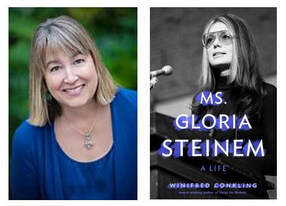 Please welcome author
Winifred Conkling
here to tell you about the biography she's written entitled
Ms. Gloria Steinem, A Life
. Reviewers call it insightful and well-researched. From Booklist,
"Readers will come away with...
a deeper appreciation for how much has changed for women during Steinem's lifetime and how much of that change was forged by Steinem herself."
Please welcome author
Winifred Conkling
here to tell you about the biography she's written entitled
Ms. Gloria Steinem, A Life
. Reviewers call it insightful and well-researched. From Booklist,
"Readers will come away with...
a deeper appreciation for how much has changed for women during Steinem's lifetime and how much of that change was forged by Steinem herself."
Winifred: I grew up listening to Gloria Steinem as the voice of the women’s movement. I read her books and heard her lecture several times, but I didn’t not appreciate the complexities of her life until I began my research for this book.
Steinem didn’t expect her life to be defined by the women’s movement. She was a reluctant revolutionary, at least in the beginning. In her twenties, Gloria thought she would spend a few years working on feminist issues and then turn her attention to other causes.
Steinem’s life epitomizes what it meant to be a twentieth-century feminist.
In the 1960s, she became a respected journalist and writer; she cofounded Ms. magazine and became a best-selling author. She wanted to make change, not just write about it. She became a political activist and social reformer; she cofounded the National Women’s Political Caucus, the Ms. Foundation, and the Women’s Media Center, among other groups. She became a leader in the women’s movement, speaking out on feminist issues for decades.
But Steinem’s life almost turned out differently. Gloria Steinem campaigns for the Equal Rights Amendment, saying "The American Dream Has Never Included Everybody." In her senior year of college, Steinem accepted a marriage proposal and a diamond engagement ring. She came close to choosing a conventional life as a wife and mother, but, in the end, she couldn’t go through with the wedding.
Gloria Steinem campaigns for the Equal Rights Amendment, saying "The American Dream Has Never Included Everybody." In her senior year of college, Steinem accepted a marriage proposal and a diamond engagement ring. She came close to choosing a conventional life as a wife and mother, but, in the end, she couldn’t go through with the wedding.
According to the conventions of the 1950s, a wife was expected to devote herself to her husband and children, but Steinem wanted a life of her own. What gave Steinem the confidence to resist social pressures of her day? Her unusual childhood experiences almost certainly shaped her adult choices. 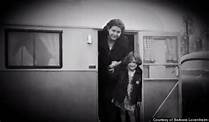 Gloria with her mother Ruth As a young girl, Steinem’s parents divorced, and she was left alone to care for her mentally unstable mother, Ruth.
Gloria with her mother Ruth As a young girl, Steinem’s parents divorced, and she was left alone to care for her mentally unstable mother, Ruth.
Steinem never questioned her mother’s love and devotion, but Ruth Steinem was unable to properly care for her daughter. During certain periods, their lives were safe and predictable, but for many years their mother/daughter roles were reversed, and Steinem was forced to care for her mother, feeding her and comforting her when she became confused or afraid
Steinem tried not to resent her mother’s illness, but she felt the burden of putting someone else’s needs ahead of her own. Years later, Steinem may have resisted the urge to become a wife and mother because she had already experienced the role of caregiver when she was a child herself.
By rejecting social convention, Steinem was free to follow her personal passions. Instead of raising a family, she devoted much of her creative energy to the women’s movement and feminist causes. Without family commitments and obligations, Steinem was also freer to be herself, without being accused of emasculating her husband or neglecting her children. She spoke only for herself, but she spoke on behalf of all women.
Every experience in Steinem’s life informed the next. Steinem studied government at Smith College in Massachusetts and graduated magna cum laude in 1956.
She earned the Chester Bowles Fellowship, which enabled her to spend two years traveling and studying in India. While overseas, she became involved with grassroots activism, which she later used in her work with the women’s movement.
When she returned to the United States, Steinem worked as an organizer and then a journalist in New York, writing freelance pieces for various publications.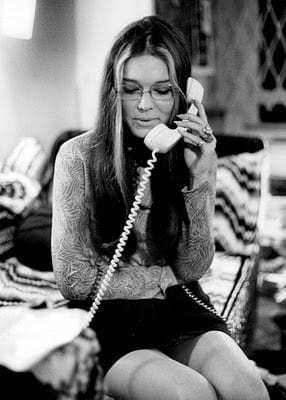 Gloria Steinem circa 1960
Gloria Steinem circa 1960 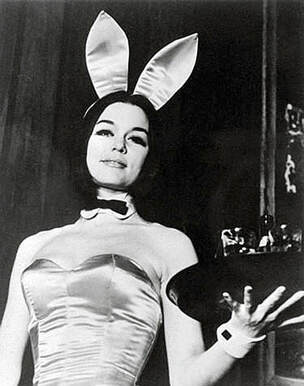 Gloria Steinem working undercover as a Playboy Bunny. (Photograph: Getty Images) “The costume was so tight, it would have given a man cleavage,” she famously said.
Gloria Steinem working undercover as a Playboy Bunny. (Photograph: Getty Images) “The costume was so tight, it would have given a man cleavage,” she famously said.
Most editors wouldn’t assign Steinem the stories she wanted to write, so in 1968 she helped launch New York magazine. Steinem reported on political campaigns and progressive social issues, including the women’s movement. Steinem recognized the need for a magazine dedicated to the women’s movement.
In 1971 she co-founded Ms. Magazine, which was first published as an insert in New York magazine. The following year, Ms. became an independent publication, and Steinem served as an editor and writer for fifteen years. (She remains an emeritus editor at Ms.)
Steinem wasn’t satisfied with writing about feminist issues. She became an activist and toured the country as a provocative speaker on college campuses and at community events.
Throughout her career, Steinem co-founded a number of organizations:National Women’s Political Caucus, which supports the election of feminists to public office Women’s Action Alliance, which promotes non-sexist, multi-racial children’s education; the Women’s Media Center, which promotes positive images of women in mediaVoters for Choice, a pro-choice political action committeeMs. Foundation for Women, which supports programs that help women with employment, reproductive health, domestic abuse, and other issues of importance to women. In 2013, Barak Obama awarded Steinem the President Medal of Freedom, the highest nonmilitary honor given by the United States government, for her lifetime of social activism and reform.
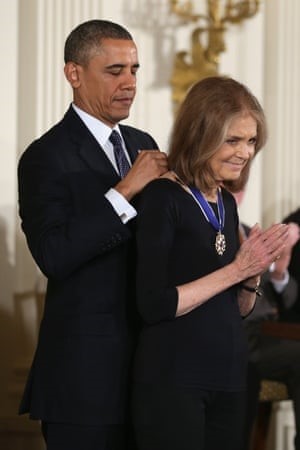 2013 Getty Images Winifred, thanks so much for giving us a quick look at the life of Gloria Steinem. This space really is too short to give justice to the the accomplishments of such an American icon. We'll all have to read
the book
!
2013 Getty Images Winifred, thanks so much for giving us a quick look at the life of Gloria Steinem. This space really is too short to give justice to the the accomplishments of such an American icon. We'll all have to read
the book
!
You may remember Winifred from her book Radioactive! How Irène Curie & Lise Meitner Revolutionized Science and Changed the World. If you missed it, here's the post: Imagine a Teenage Girl Goes to War to Impress Her Mom, and that’s Just the Beginning.
To learn more about Author Winifred Conkling and her books, check out her website here...
“I’ve learned that this [feminism]is not something we care about for a year or two or three,” Ms. Steinem wrote. “We are in it for life – and for our lives.”
 Please welcome author
Winifred Conkling
here to tell you about the biography she's written entitled
Ms. Gloria Steinem, A Life
. Reviewers call it insightful and well-researched. From Booklist,
"Readers will come away with...
a deeper appreciation for how much has changed for women during Steinem's lifetime and how much of that change was forged by Steinem herself."
Please welcome author
Winifred Conkling
here to tell you about the biography she's written entitled
Ms. Gloria Steinem, A Life
. Reviewers call it insightful and well-researched. From Booklist,
"Readers will come away with...
a deeper appreciation for how much has changed for women during Steinem's lifetime and how much of that change was forged by Steinem herself."
Winifred: I grew up listening to Gloria Steinem as the voice of the women’s movement. I read her books and heard her lecture several times, but I didn’t not appreciate the complexities of her life until I began my research for this book.
Steinem didn’t expect her life to be defined by the women’s movement. She was a reluctant revolutionary, at least in the beginning. In her twenties, Gloria thought she would spend a few years working on feminist issues and then turn her attention to other causes.
Steinem’s life epitomizes what it meant to be a twentieth-century feminist.
In the 1960s, she became a respected journalist and writer; she cofounded Ms. magazine and became a best-selling author. She wanted to make change, not just write about it. She became a political activist and social reformer; she cofounded the National Women’s Political Caucus, the Ms. Foundation, and the Women’s Media Center, among other groups. She became a leader in the women’s movement, speaking out on feminist issues for decades.
But Steinem’s life almost turned out differently.
 Gloria Steinem campaigns for the Equal Rights Amendment, saying "The American Dream Has Never Included Everybody." In her senior year of college, Steinem accepted a marriage proposal and a diamond engagement ring. She came close to choosing a conventional life as a wife and mother, but, in the end, she couldn’t go through with the wedding.
Gloria Steinem campaigns for the Equal Rights Amendment, saying "The American Dream Has Never Included Everybody." In her senior year of college, Steinem accepted a marriage proposal and a diamond engagement ring. She came close to choosing a conventional life as a wife and mother, but, in the end, she couldn’t go through with the wedding.According to the conventions of the 1950s, a wife was expected to devote herself to her husband and children, but Steinem wanted a life of her own. What gave Steinem the confidence to resist social pressures of her day? Her unusual childhood experiences almost certainly shaped her adult choices.
 Gloria with her mother Ruth As a young girl, Steinem’s parents divorced, and she was left alone to care for her mentally unstable mother, Ruth.
Gloria with her mother Ruth As a young girl, Steinem’s parents divorced, and she was left alone to care for her mentally unstable mother, Ruth.
Steinem never questioned her mother’s love and devotion, but Ruth Steinem was unable to properly care for her daughter. During certain periods, their lives were safe and predictable, but for many years their mother/daughter roles were reversed, and Steinem was forced to care for her mother, feeding her and comforting her when she became confused or afraid
Steinem tried not to resent her mother’s illness, but she felt the burden of putting someone else’s needs ahead of her own. Years later, Steinem may have resisted the urge to become a wife and mother because she had already experienced the role of caregiver when she was a child herself.
By rejecting social convention, Steinem was free to follow her personal passions. Instead of raising a family, she devoted much of her creative energy to the women’s movement and feminist causes. Without family commitments and obligations, Steinem was also freer to be herself, without being accused of emasculating her husband or neglecting her children. She spoke only for herself, but she spoke on behalf of all women.
Every experience in Steinem’s life informed the next. Steinem studied government at Smith College in Massachusetts and graduated magna cum laude in 1956.
She earned the Chester Bowles Fellowship, which enabled her to spend two years traveling and studying in India. While overseas, she became involved with grassroots activism, which she later used in her work with the women’s movement.
When she returned to the United States, Steinem worked as an organizer and then a journalist in New York, writing freelance pieces for various publications.
 Gloria Steinem circa 1960
Gloria Steinem circa 1960  Gloria Steinem working undercover as a Playboy Bunny. (Photograph: Getty Images) “The costume was so tight, it would have given a man cleavage,” she famously said.
Gloria Steinem working undercover as a Playboy Bunny. (Photograph: Getty Images) “The costume was so tight, it would have given a man cleavage,” she famously said.Most editors wouldn’t assign Steinem the stories she wanted to write, so in 1968 she helped launch New York magazine. Steinem reported on political campaigns and progressive social issues, including the women’s movement. Steinem recognized the need for a magazine dedicated to the women’s movement.
In 1971 she co-founded Ms. Magazine, which was first published as an insert in New York magazine. The following year, Ms. became an independent publication, and Steinem served as an editor and writer for fifteen years. (She remains an emeritus editor at Ms.)
Steinem wasn’t satisfied with writing about feminist issues. She became an activist and toured the country as a provocative speaker on college campuses and at community events.
Throughout her career, Steinem co-founded a number of organizations:National Women’s Political Caucus, which supports the election of feminists to public office Women’s Action Alliance, which promotes non-sexist, multi-racial children’s education; the Women’s Media Center, which promotes positive images of women in mediaVoters for Choice, a pro-choice political action committeeMs. Foundation for Women, which supports programs that help women with employment, reproductive health, domestic abuse, and other issues of importance to women. In 2013, Barak Obama awarded Steinem the President Medal of Freedom, the highest nonmilitary honor given by the United States government, for her lifetime of social activism and reform.
 2013 Getty Images Winifred, thanks so much for giving us a quick look at the life of Gloria Steinem. This space really is too short to give justice to the the accomplishments of such an American icon. We'll all have to read
the book
!
2013 Getty Images Winifred, thanks so much for giving us a quick look at the life of Gloria Steinem. This space really is too short to give justice to the the accomplishments of such an American icon. We'll all have to read
the book
!You may remember Winifred from her book Radioactive! How Irène Curie & Lise Meitner Revolutionized Science and Changed the World. If you missed it, here's the post: Imagine a Teenage Girl Goes to War to Impress Her Mom, and that’s Just the Beginning.
To learn more about Author Winifred Conkling and her books, check out her website here...
Published on March 02, 2021 14:15
February 16, 2021
PLENTY of HEROINES SERVED IN VIETNAM
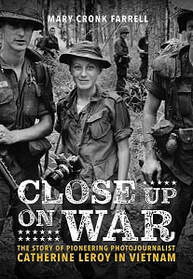 Last week I revealed the cover of my new book!
Last week I revealed the cover of my new book! Close Up on War: The Story of Pioneering Photojournalist Catherine Leroy in Vietnam is scheduled for release in early 2021. But it is available now for pre-order .
Catherine Leroy spent most of her time in Vietnam in the field with U.S. troops. She rarely saw American women, even female journalists who were there at the same time.
Plenty of military and civilian women went to Vietnam War during the war, but their service and sacrifice was not always appreciated.
Brown said if the committee
considered installing a statue honoring women,
"then they might find themselves having to consider
doing one for the dogs who served."
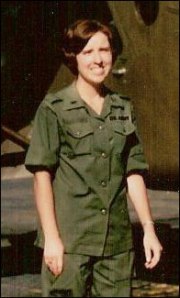 US Army Nurse Diane Carlson [Evans] in Vietnam 1968.
US Army Nurse Diane Carlson [Evans] in Vietnam 1968. More than 6,000 military nurses, most of them female, served during the war. Eight women died.
I first learned of former army nurse Diane Carlson Evans when she wrote the forward for my book Pure Grit: How US Military Nurses Survived Battle and Prison Camp in the Pacific . She was instrumental the fight to get a Vietnam Veteran's Memorial constructed in Washington DC.
Diane had been born and raised on a dairy farm in rural Minnesota and moved to the city to attend nursing school in Minneapolis, after which she joined the Army Nurse Corps. She arrived in Vietnam in 1968, when she was twenty-two. The blast of heat and the smell of jet fuel hit me first, then the sight of GIs with MI6s and bandoliers of ammunition slung across their strapping chests.
Diane knew that her parents would be watching the war unfold on the nightly news. The saw the body bags, helicopters crashing into the jungle, napalm burning villages and civilians running from the flames.
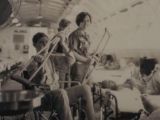 Diane Carlson Evans, 36th Evacuation Hospital, Vung Tau, South Vietnam.
But what they did not see were the nurses in helmets and flak jackets running to the hospitals and treating the men whose torsos and limbs had been ripped open by high-velocity weapons.
Diane Carlson Evans, 36th Evacuation Hospital, Vung Tau, South Vietnam.
But what they did not see were the nurses in helmets and flak jackets running to the hospitals and treating the men whose torsos and limbs had been ripped open by high-velocity weapons.
They did not hear the sound of mortar thuds and rockets piercing our billets and hospital roofs and walls or see us throwing mattresses on top of the patients to protect them from shrapnel.
They did not see us hanging blood bags, suctioning tracheotomies, and frantically evacuating patients from the hospital to allow more room for mass casualties.
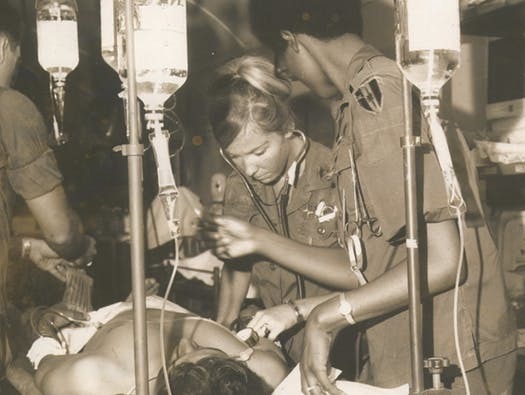 Army nurses, 93rd Evacuation Hospital, Long Binh, Vietnam, 1968. Diane, shown below at work at the 36th Evac Hospital, had seen trauma close up as a nurse in Minnesota. But farm mishaps, auto accidents, drownings, and homicides, she says, could be understood and accounted for.
Army nurses, 93rd Evacuation Hospital, Long Binh, Vietnam, 1968. Diane, shown below at work at the 36th Evac Hospital, had seen trauma close up as a nurse in Minnesota. But farm mishaps, auto accidents, drownings, and homicides, she says, could be understood and accounted for. In Vietnam, I was overwhelmed by the hundreds of our young soldiers, Vietnamese and Montagnard civilians who had been blown apart by heinous weapons of war.
In Vietnam, I was overwhelmed by the hundreds of our young soldiers, Vietnamese and Montagnard civilians who had been blown apart by heinous weapons of war.
I hadn’t realized how much loving the soldiers would make me hate the war. I wanted to know what they were dying for.
Two decades after her year-long tour, Diane founded the Vietnam Nurses Memorial Project, later expanded to include all American women of the Vietnam War. She had no idea it would take seven years of testimony before three federal commissions and two congressional bills to gain permission for a memorial to honor the women she had served with in Vietnam.
One man represents the kind of attitude Diane and her fellow veterans encountered. Carter Brown led the federal Commission on Fine Arts, which they hoped to get on their side. But when the group approached him for support, he demurred. Brown said if the committee considered installing a statue honoring women, "then they might find themselves having to consider doing one for the dogs who served." After what these nurses accomplished in Vietnam, one misogynist bureaucrat and those of similar attitude would not stop them. After their steady efforts for nine years, this statue was dedicated, November 1993, on the Mall in Washington DC near the famous Vietnam Veterans Memorial.
 The 15-foot bronze, designed by sculptor Glenna Goodacre, helps serve the mission of the Vietnam Women’s Memorial Project Foundation, including to promote healing of the 11,000 women, including nurses, other military women and civilians who served.
The 15-foot bronze, designed by sculptor Glenna Goodacre, helps serve the mission of the Vietnam Women’s Memorial Project Foundation, including to promote healing of the 11,000 women, including nurses, other military women and civilians who served.The sculpture also helps educate the public about women's roles in the conflict and helps facilitate research into the after affects of their wartime experiences.
Sources
https://vvmf.wordpress.com/2013/03/20...
https://www.startribune.com/women-in-...
Vietnam Women's Memorial: History of the Vietnam Women's Memorial
Foreword, Diane Carlson Evans, Pure Grit: How American WWII Nurses Survived Battle and Prison Camp in the Pacific
Published on February 16, 2021 16:00
PLENTY HEROINES SERVED IN VIETNAM
 Last week I revealed the cover of my new book!
Last week I revealed the cover of my new book! Close Up on War: The Story of Pioneering Photojournalist Catherine Leroy in Vietnam is scheduled for release in early 2021. But it is available now for pre-order .
Catherine Leroy spent most of her time in Vietnam in the field with U.S. troops. She rarely saw American women, even female journalists who were there at the same time.
Plenty of military and civilian women went to Vietnam War during the war, but their service and sacrifice was not always appreciated.
Brown said if the committee
considered installing a statue honoring women,
"then they might find themselves having to consider
doing one for the dogs who served."
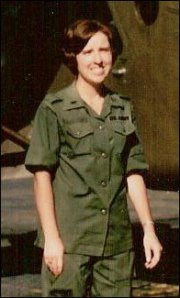 US Army Nurse Diane Carlson [Evans] in Vietnam 1968.
US Army Nurse Diane Carlson [Evans] in Vietnam 1968. More than 6,000 military nurses, most of them female, served during the war. Eight women died.
I first learned of former army nurse Diane Carlson Evans when she wrote the forward for my book Pure Grit: How US Military Nurses Survived Battle and Prison Camp in the Pacific . She was instrumental the fight to get a Vietnam Veteran's Memorial constructed in Washington DC.
Diane had been born and raised on a dairy farm in rural Minnesota and moved to the city to attend nursing school in Minneapolis, after which she joined the Army Nurse Corps. She arrived in Vietnam in 1968, when she was twenty-two. The blast of heat and the smell of jet fuel hit me first, then the sight of GIs with MI6s and bandoliers of ammunition slung across their strapping chests.
Diane knew that her parents would be watching the war unfold on the nightly news. The saw the body bags, helicopters crashing into the jungle, napalm burning villages and civilians running from the flames.
 Diane Carlson Evans, 36th Evacuation Hospital, Vung Tau, South Vietnam.
But what they did not see were the nurses in helmets and flak jackets running to the hospitals and treating the men whose torsos and limbs had been ripped open by high-velocity weapons.
Diane Carlson Evans, 36th Evacuation Hospital, Vung Tau, South Vietnam.
But what they did not see were the nurses in helmets and flak jackets running to the hospitals and treating the men whose torsos and limbs had been ripped open by high-velocity weapons.
They did not hear the sound of mortar thuds and rockets piercing our billets and hospital roofs and walls or see us throwing mattresses on top of the patients to protect them from shrapnel.
They did not see us hanging blood bags, suctioning tracheotomies, and frantically evacuating patients from the hospital to allow more room for mass casualties.
 Army nurses, 93rd Evacuation Hospital, Long Binh, Vietnam, 1968. Diane, shown below at work at the 36th Evac Hospital, had seen trauma close up as a nurse in Minnesota. But farm mishaps, auto accidents, drownings, and homicides, she says, could be understood and accounted for.
Army nurses, 93rd Evacuation Hospital, Long Binh, Vietnam, 1968. Diane, shown below at work at the 36th Evac Hospital, had seen trauma close up as a nurse in Minnesota. But farm mishaps, auto accidents, drownings, and homicides, she says, could be understood and accounted for. In Vietnam, I was overwhelmed by the hundreds of our young soldiers, Vietnamese and Montagnard civilians who had been blown apart by heinous weapons of war.
In Vietnam, I was overwhelmed by the hundreds of our young soldiers, Vietnamese and Montagnard civilians who had been blown apart by heinous weapons of war.
I hadn’t realized how much loving the soldiers would make me hate the war. I wanted to know what they were dying for.
Two decades after her year-long tour, Diane founded the Vietnam Nurses Memorial Project, later expanded to include all American women of the Vietnam War. She had no idea it would take seven years of testimony before three federal commissions and two congressional bills to gain permission for a memorial to honor the women she had served with in Vietnam.
One man represents the kind of attitude Diane and her fellow veterans encountered. Carter Brown led the federal Commission on Fine Arts, which they hoped to get on their side. But when the group approached him for support, he demurred. Brown said if the committee considered installing a statue honoring women, "then they might find themselves having to consider doing one for the dogs who served." After what these nurses accomplished in Vietnam, one misogynist bureaucrat and those of similar attitude would not stop them. After their steady efforts for nine years, this statue was dedicated, November 1993, on the Mall in Washington DC near the famous Vietnam Veterans Memorial.
 The 15-foot bronze, designed by sculptor Glenna Goodacre, helps serve the mission of the Vietnam Women’s Memorial Project Foundation, including to promote healing of the 11,000 women, including nurses, other military women and civilians who served.
The 15-foot bronze, designed by sculptor Glenna Goodacre, helps serve the mission of the Vietnam Women’s Memorial Project Foundation, including to promote healing of the 11,000 women, including nurses, other military women and civilians who served.The sculpture also helps educate the public about women's roles in the conflict and helps facilitate research into the after affects of their wartime experiences.
Sources
https://vvmf.wordpress.com/2013/03/20...
https://www.startribune.com/women-in-...
Vietnam Women's Memorial: History of the Vietnam Women's Memorial
Foreword, Diane Carlson Evans, Pure Grit: How American WWII Nurses Survived Battle and Prison Camp in the Pacific
Published on February 16, 2021 16:00
February 10, 2021
The Enemy at Home
This past week marked the anniversary of one of the most crucial moments in American civil rights history. February 7, 1942, African Americans launched the Double V Campaign.
It started with one man's question. "Should I sacrifice my life to live half American?"
And it burgeoned into a force for equal employment opportunity for blacks during World War II, and laid a foundation for the civil rights marches in the 1960s.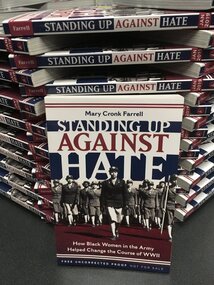
I wrote about the Double V Campaign in my book Standing up Against Hate . There's one passage that still chokes me up every time I read it.
The Enemy at Home was the working title for my book chronicling black women's service in the US army during WWII.
One of the things that struck me most profoundly when working on the story, was the women's willingness to join a segregated army and serve a country that did not recognize them as equal citizens. Some recruits from the north arrived at basic training to face the shock of segregation for the first time in their lives. Lieutenant Dovey Johnson Not Dovey Johnson, who'd grown up in Charlotte, North Carolina. When she tried to apply for the Women's Army Auxiliary Corps, nobody in Charlotte would give her an application.
Lieutenant Dovey Johnson Not Dovey Johnson, who'd grown up in Charlotte, North Carolina. When she tried to apply for the Women's Army Auxiliary Corps, nobody in Charlotte would give her an application.
She moved to Washington DC to get her hands on an application. After completed the segregated training, Dovey became one of the first black women commissioned an US Army Officer.
Was it coincidence Lieutenant Dovey Johnson was assigned to recruiting duties in Georgia, and North and South Carolina? Maybe, maybe not. But they sent one very determined woman south of the Mason-Dixon line.
Dovey feared the small gains black women had made in becoming officers in the army would be lost, unless more black women volunteered.
“That, I determined, would not happen—not on my watch, no matter how tough a sell I had on my hands in pitching a Jim Crow WAAC in the Deep South.”
“Was that opportunity precisely, mathematically, documentable equal to that of whites? probably not. But the WAAC offered a chance I believed would never come again in quite the same way: the chance to advance, to train for careers, to build the kind of future we women wanted for our children, to stand behind the men who were fighting in Europe and North Africa and the Pacific. That mattered most of all. Our boys were dying for freedom, I pointed out in every speech I made. What was segregation compared to that?”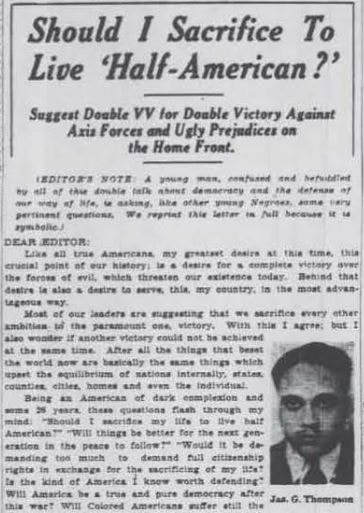 Across the country, many blacks did not share Dovey's enthusiasm. Popular V for victory signs had popped up to cheer the fight against race prejudice, aggression and tyranny in Europe and Asia.
Across the country, many blacks did not share Dovey's enthusiasm. Popular V for victory signs had popped up to cheer the fight against race prejudice, aggression and tyranny in Europe and Asia.
One black man, James G. Thompson, wrote a letter to a prominent black newspaper,
The Pittsburgh Courier.
Thompson wrote in part: Being an American of dark complexion and some 26 years, these questions flash through my mind: “Should I sacrifice my life to live half American?”
“Will things be better in the next generation for the peace to follow?”
“Will Colored Americans suffer still the indignities that have been so heaped upon them in the past?”
These and other questions need answering: I want to know and I believe every colored American who is thinking, wants to know.
Thompson went on to suggest doubling the V for Victory.
The first V for victory over our enemies from without, the second V for victory over our enemies from within. For surely those who perpetuate these ugly prejudices here are seeking to destroy our democratic form of government just as surely as the Axis forces. The Pittsburgh Courier had swiftly drawn the connection in 1939, between treatment of blacks in the US and Nazi Germany’s treatment of Jews.
The Pittsburgh Courier had swiftly drawn the connection in 1939, between treatment of blacks in the US and Nazi Germany’s treatment of Jews.
President Franklin D. Roosevelt asked the Courier to tone down its rhetoric about racial discrimination. And the paper did let up. Until the US joined the war, and huge numbers of blacks were drafted for service.
The newspaper asked readers what they thought about this Double V. Hundreds of telegrams and letters inundated the newspaper's office voicing agreement.
The Courier established the Double V Campaign as "the true battle cry of colored America....the Double "V" war cry–[signifies] victory over...our enslavers at home and those abroad who would enslave us. WE HAVE A STAKE IN THIS FIGHT....WE ARE AMERICANS TOO!"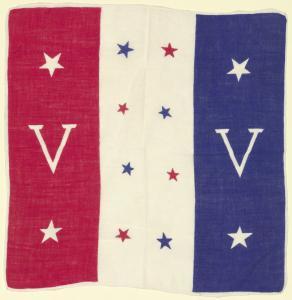 Double V handkerchief By the summer 200-thousand black people had joined the Double V Campaign, each paying a nickel to the Courier, which continued to promote the slogan, dedicating close to 15% of its newspaper to the subject each week.
Double V handkerchief By the summer 200-thousand black people had joined the Double V Campaign, each paying a nickel to the Courier, which continued to promote the slogan, dedicating close to 15% of its newspaper to the subject each week.
Newspaper Historian Patrick Washburn describes the fervor. "Y ou had women walking around with Double V's on their dresses. You had a new hairstyle called the Doubler where black women would weave two—;two V's in their hair. You had Double V baseball games, Double V flag waving ceremonies, Double V gardens. I mean it's just Double V this, Double V [that]....There was even a Double V song."
But no amount of Double V's guaranteed progress against racism in America and skepticism ran deep. Civil Rights activists A. Philip Randolph and Bayard Rustin knew that now, when the country was in crisis and needed them, it was time to demand equality.
They organized a massive March on Washington to pressure President Roosevelt. The president had promised the US would become the “arsenal of democracy." American industry and manufacturing would have to gear up as never before.
Randolph and Rustin organized tens of thousands of blacks to march on the capital demanding equal opportunity to the millions of high-paying jobs that would result.
Such a display of America's racial injustice would be embarrassing on the world stage.
President Roosevelt asked Randolph to call off the demonstration promising an executive order to increase job opportunity for blacks.
In June, 1941, Executive Order 8802 banned discrimination in defense industries and government and created the Fair Employment Practices Committee for enforcement. Luedell Mitchell and Lavada Cherry helping build an airplane in the El Segundo Plant of the Douglas Aircraft Company (Library of Congress)
Luedell Mitchell and Lavada Cherry helping build an airplane in the El Segundo Plant of the Douglas Aircraft Company (Library of Congress)
Executive Order 8802 was the first time since Reconstruction that the federal government explicitly protected equal rights for African Americans. Though enforcement was not ideal, civil rights activists now had a tool in their "arsenal for democracy."
Despite the Double V campaign, segregation and racial injustice continued after the war. But it helped lay the foundation for 1960's protest marches in the fight for the Civil Rights Act of 1964.
If you enjoyed this story, Click and sign up here to get another every week in my author newsletter.
Sources
The Double V Campaign (1942-1945) (blackpast.org)
Executive Order 8802 - Teaching American History
http://explorepahistory.com/kora/files/1/2/1-2-F3C-25-ExplorePAHistory-a0k1v1-a_349.jpg
It started with one man's question. "Should I sacrifice my life to live half American?"
And it burgeoned into a force for equal employment opportunity for blacks during World War II, and laid a foundation for the civil rights marches in the 1960s.

I wrote about the Double V Campaign in my book Standing up Against Hate . There's one passage that still chokes me up every time I read it.
The Enemy at Home was the working title for my book chronicling black women's service in the US army during WWII.
One of the things that struck me most profoundly when working on the story, was the women's willingness to join a segregated army and serve a country that did not recognize them as equal citizens. Some recruits from the north arrived at basic training to face the shock of segregation for the first time in their lives.
 Lieutenant Dovey Johnson Not Dovey Johnson, who'd grown up in Charlotte, North Carolina. When she tried to apply for the Women's Army Auxiliary Corps, nobody in Charlotte would give her an application.
Lieutenant Dovey Johnson Not Dovey Johnson, who'd grown up in Charlotte, North Carolina. When she tried to apply for the Women's Army Auxiliary Corps, nobody in Charlotte would give her an application.She moved to Washington DC to get her hands on an application. After completed the segregated training, Dovey became one of the first black women commissioned an US Army Officer.
Was it coincidence Lieutenant Dovey Johnson was assigned to recruiting duties in Georgia, and North and South Carolina? Maybe, maybe not. But they sent one very determined woman south of the Mason-Dixon line.
Dovey feared the small gains black women had made in becoming officers in the army would be lost, unless more black women volunteered.
“That, I determined, would not happen—not on my watch, no matter how tough a sell I had on my hands in pitching a Jim Crow WAAC in the Deep South.”
“Was that opportunity precisely, mathematically, documentable equal to that of whites? probably not. But the WAAC offered a chance I believed would never come again in quite the same way: the chance to advance, to train for careers, to build the kind of future we women wanted for our children, to stand behind the men who were fighting in Europe and North Africa and the Pacific. That mattered most of all. Our boys were dying for freedom, I pointed out in every speech I made. What was segregation compared to that?”
 Across the country, many blacks did not share Dovey's enthusiasm. Popular V for victory signs had popped up to cheer the fight against race prejudice, aggression and tyranny in Europe and Asia.
Across the country, many blacks did not share Dovey's enthusiasm. Popular V for victory signs had popped up to cheer the fight against race prejudice, aggression and tyranny in Europe and Asia. One black man, James G. Thompson, wrote a letter to a prominent black newspaper,
The Pittsburgh Courier.
Thompson wrote in part: Being an American of dark complexion and some 26 years, these questions flash through my mind: “Should I sacrifice my life to live half American?”
“Will things be better in the next generation for the peace to follow?”
“Will Colored Americans suffer still the indignities that have been so heaped upon them in the past?”
These and other questions need answering: I want to know and I believe every colored American who is thinking, wants to know.
Thompson went on to suggest doubling the V for Victory.
The first V for victory over our enemies from without, the second V for victory over our enemies from within. For surely those who perpetuate these ugly prejudices here are seeking to destroy our democratic form of government just as surely as the Axis forces.
 The Pittsburgh Courier had swiftly drawn the connection in 1939, between treatment of blacks in the US and Nazi Germany’s treatment of Jews.
The Pittsburgh Courier had swiftly drawn the connection in 1939, between treatment of blacks in the US and Nazi Germany’s treatment of Jews.President Franklin D. Roosevelt asked the Courier to tone down its rhetoric about racial discrimination. And the paper did let up. Until the US joined the war, and huge numbers of blacks were drafted for service.
The newspaper asked readers what they thought about this Double V. Hundreds of telegrams and letters inundated the newspaper's office voicing agreement.
The Courier established the Double V Campaign as "the true battle cry of colored America....the Double "V" war cry–[signifies] victory over...our enslavers at home and those abroad who would enslave us. WE HAVE A STAKE IN THIS FIGHT....WE ARE AMERICANS TOO!"
 Double V handkerchief By the summer 200-thousand black people had joined the Double V Campaign, each paying a nickel to the Courier, which continued to promote the slogan, dedicating close to 15% of its newspaper to the subject each week.
Double V handkerchief By the summer 200-thousand black people had joined the Double V Campaign, each paying a nickel to the Courier, which continued to promote the slogan, dedicating close to 15% of its newspaper to the subject each week. Newspaper Historian Patrick Washburn describes the fervor. "Y ou had women walking around with Double V's on their dresses. You had a new hairstyle called the Doubler where black women would weave two—;two V's in their hair. You had Double V baseball games, Double V flag waving ceremonies, Double V gardens. I mean it's just Double V this, Double V [that]....There was even a Double V song."
But no amount of Double V's guaranteed progress against racism in America and skepticism ran deep. Civil Rights activists A. Philip Randolph and Bayard Rustin knew that now, when the country was in crisis and needed them, it was time to demand equality.
They organized a massive March on Washington to pressure President Roosevelt. The president had promised the US would become the “arsenal of democracy." American industry and manufacturing would have to gear up as never before.
Randolph and Rustin organized tens of thousands of blacks to march on the capital demanding equal opportunity to the millions of high-paying jobs that would result.
Such a display of America's racial injustice would be embarrassing on the world stage.
President Roosevelt asked Randolph to call off the demonstration promising an executive order to increase job opportunity for blacks.
In June, 1941, Executive Order 8802 banned discrimination in defense industries and government and created the Fair Employment Practices Committee for enforcement.
 Luedell Mitchell and Lavada Cherry helping build an airplane in the El Segundo Plant of the Douglas Aircraft Company (Library of Congress)
Luedell Mitchell and Lavada Cherry helping build an airplane in the El Segundo Plant of the Douglas Aircraft Company (Library of Congress)Executive Order 8802 was the first time since Reconstruction that the federal government explicitly protected equal rights for African Americans. Though enforcement was not ideal, civil rights activists now had a tool in their "arsenal for democracy."
Despite the Double V campaign, segregation and racial injustice continued after the war. But it helped lay the foundation for 1960's protest marches in the fight for the Civil Rights Act of 1964.
If you enjoyed this story, Click and sign up here to get another every week in my author newsletter.
Sources
The Double V Campaign (1942-1945) (blackpast.org)
Executive Order 8802 - Teaching American History
http://explorepahistory.com/kora/files/1/2/1-2-F3C-25-ExplorePAHistory-a0k1v1-a_349.jpg
Published on February 10, 2021 04:30
January 28, 2021
A Spy in the White House
It's been a crazy month.
A divided nation, reeling from the pandemic, now hit with cruel storms from coast to coast.
I support our new president, but politics is not going to solve all our problems. We the people...have to step up. All of us little people, doing little everyday things, but with intention and courage like never before.
Americans have done it before. Like Mary Richards Browser, an almost completely unknown black woman, who risked her life to become a spy in the Confederate White House, help free her people and preserve the union during the Civil War.
There are few records to help us reconstruct the life of Mary Richards Browser, but there is evidence she worked as a spy in the very seat of the Confederate government, reporting secrets to the Union Army until fleeing for her life.
No existing photos are known to picture Mary, though at least one floating around the internet is falsely reported to portray her.
So up stepped a girl, who imagined how Mary Richards Browser might have looked, and posed for a portrait.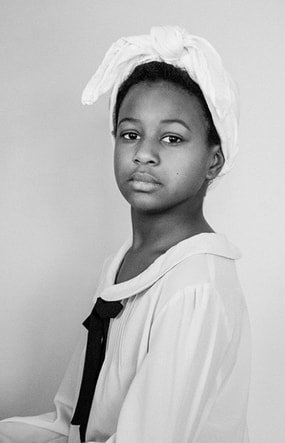 Her Story: A Women's History Project http://shemadehistory.com/her-story-m...
Her Story: A Women's History Project http://shemadehistory.com/her-story-m...
She's not claiming this is an exact image of Mary. It's an effort to discover and connect with a significant women of history, one of many black women who've never been written about in our history books.
"Our goal is to highlight their contributions to this world," says her mother, "to make their stories accessible to all women and girls that are in the process of creating their own history."
We know something of Richards Browser from Church records of her baptism: “Mary Jane, a colored child belonging to Mrs. Van Lew” St. John’s Church in Richmond, May 17, 1846.
John Van Lew and his wife, originally northerners, became prosperous in Richmond and moved in elite social circles. But their daughter Elizabeth was educated in a Quaker school and believed slavery was wrong.
When her father died, she and her mother freed the family's slaves, and Elizabeth took Mary north to get an education. In 1855, at what appears to be Elizabeth's direction, Mary sailed to Liberia as a missionary. Five years later she returned to the Van Lew's mansion in Richmond.
According to Saint John's records, she married Wilson Browser another of the black servants of Mrs. Van Lew the following year, April 16, 1861. The next day, Virginia seceded from the United States. An in August Jefferson Davis moved to a mansion which would serve as the Executive offices of the Confederacy until the end of the war. Only ninety miles ran between the White House in Washington D.C. and the White House in Richmond and soon Elizabeth Van Lew ran a sophisticated spy ring in on behalf of the Union Army.
Only ninety miles ran between the White House in Washington D.C. and the White House in Richmond and soon Elizabeth Van Lew ran a sophisticated spy ring in on behalf of the Union Army.
"The chief source of information to the enemy," Gen. Robert E. Lee, commander of the Confederate Army, said in May 1863, "is through our negroes."
We don't know when Mary Richards Browsers took a domestic position for the president of the Confederacy, but President Davis complained of an intelligence leak throughout the war. His wife Varina Davis publicly denied that any black enslaved woman could have spied on them. It's believed that Mary, an intelligent, educated free woman played the part of a simple-minded, though competent domestic slave.
It's believed that Mary, an intelligent, educated free woman played the part of a simple-minded, though competent domestic slave.
She listened in on dinner conversation at the president's table and possibly even his meetings. Davis assumed she was illiterate, so when cleaning his office, she had free access to his papers.
Whatever intelligence Mary gathered, she passed to Elizabeth Van Lew, though other spies in the network.
Elizbeth was spurned by other Richmond families for being an abolitionist, but they never knew the extent of her work. She kept a hidden diary where she on May 14, 1864, she wrote, "When I open my eyes in the morning, I say to the servant, 'What news, Mary?' and my caterer never fails! Most generally our reliable news is gathered from negroes, and they certainly show wisdom, discretion and prudence which is wonderful."
Mary fled the Confederate White House, near the end of the war and all records of the Van Lew spy ring were destroyed to protect Mary and the others. Mary traveled in the north for a time speaking to gatherings of people about her work as a spy. But she did so under several different aliases, continuing to fear for her life.
Mary also worked tirelessly to educate blacks. In 1867, she started a freedmen's school in Saint Mary's, Georgia. Correspondence has been discovered and preserved between Mary and the Georgia Superintendent of Freedman Schools.
On April 7, 1867, she wrote: “I wish there was some law here, or some protection. I know these southerners pretty well and their present appearance is not at all favorable. I have been in the service so long as a detective that I still find myself scrutinizing them closely. There is little of the open braggadocio that generally characterizes them, but there is that sinister expression about the eye, and the quiet but bitterly expressed feeling that I know portends evil. With a little whiskey in them, they dare do anything. Their apparent good feelings and acquiescence are only a vail to hide their true feelings.”
Soon after, the trail goes cold when searching for details about Mary Richards Browser's life. However in 1995, she was inducted into the Military Intelligence Hall of Fame in Fort Huachuca, Arizona by the U.S. government.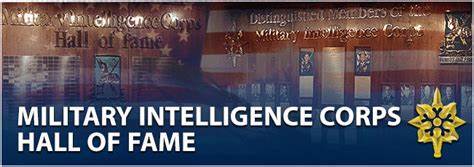 The acknowledgement of her work reads in part:
“Ms. Bowser certainly succeeded in a highly dangerous mission to the great benefit of the Union effort. She was one of the highest placed and most productive espionage agents of the Civil War.”
The acknowledgement of her work reads in part:
“Ms. Bowser certainly succeeded in a highly dangerous mission to the great benefit of the Union effort. She was one of the highest placed and most productive espionage agents of the Civil War.”
Most likely, Mary did not set out to have her name engraved on a plaque for others to see a century after her death, nor to be inducted in any hall of fame. What Mary did, was to fully engage in the circumstances in which she found herself and follow her inner compass for good.
In the place and time Mary happened to find herself, she made her small everyday interactions with intention and courage, adding them to a larger movement toward justice. With thanks to these sources:
http://shemadehistory.com/her-story-mary-bowser/
https://www.encyclopediavirginia.org/Bowser_Mary_Richards_fl_1846-1867#contrib
www.history.com/news/female-spies-civil-war-mary-bowser-elizabeth-van-lew
https://murphybrowneblog.wordpress.com/2018/03/29/mary-elizabeth-bowser-union-spy/
A divided nation, reeling from the pandemic, now hit with cruel storms from coast to coast.
I support our new president, but politics is not going to solve all our problems. We the people...have to step up. All of us little people, doing little everyday things, but with intention and courage like never before.
Americans have done it before. Like Mary Richards Browser, an almost completely unknown black woman, who risked her life to become a spy in the Confederate White House, help free her people and preserve the union during the Civil War.
There are few records to help us reconstruct the life of Mary Richards Browser, but there is evidence she worked as a spy in the very seat of the Confederate government, reporting secrets to the Union Army until fleeing for her life.
No existing photos are known to picture Mary, though at least one floating around the internet is falsely reported to portray her.
So up stepped a girl, who imagined how Mary Richards Browser might have looked, and posed for a portrait.
 Her Story: A Women's History Project http://shemadehistory.com/her-story-m...
Her Story: A Women's History Project http://shemadehistory.com/her-story-m... She's not claiming this is an exact image of Mary. It's an effort to discover and connect with a significant women of history, one of many black women who've never been written about in our history books.
"Our goal is to highlight their contributions to this world," says her mother, "to make their stories accessible to all women and girls that are in the process of creating their own history."
We know something of Richards Browser from Church records of her baptism: “Mary Jane, a colored child belonging to Mrs. Van Lew” St. John’s Church in Richmond, May 17, 1846.
John Van Lew and his wife, originally northerners, became prosperous in Richmond and moved in elite social circles. But their daughter Elizabeth was educated in a Quaker school and believed slavery was wrong.
When her father died, she and her mother freed the family's slaves, and Elizabeth took Mary north to get an education. In 1855, at what appears to be Elizabeth's direction, Mary sailed to Liberia as a missionary. Five years later she returned to the Van Lew's mansion in Richmond.
According to Saint John's records, she married Wilson Browser another of the black servants of Mrs. Van Lew the following year, April 16, 1861. The next day, Virginia seceded from the United States. An in August Jefferson Davis moved to a mansion which would serve as the Executive offices of the Confederacy until the end of the war.
 Only ninety miles ran between the White House in Washington D.C. and the White House in Richmond and soon Elizabeth Van Lew ran a sophisticated spy ring in on behalf of the Union Army.
Only ninety miles ran between the White House in Washington D.C. and the White House in Richmond and soon Elizabeth Van Lew ran a sophisticated spy ring in on behalf of the Union Army."The chief source of information to the enemy," Gen. Robert E. Lee, commander of the Confederate Army, said in May 1863, "is through our negroes."
We don't know when Mary Richards Browsers took a domestic position for the president of the Confederacy, but President Davis complained of an intelligence leak throughout the war. His wife Varina Davis publicly denied that any black enslaved woman could have spied on them.
 It's believed that Mary, an intelligent, educated free woman played the part of a simple-minded, though competent domestic slave.
It's believed that Mary, an intelligent, educated free woman played the part of a simple-minded, though competent domestic slave.She listened in on dinner conversation at the president's table and possibly even his meetings. Davis assumed she was illiterate, so when cleaning his office, she had free access to his papers.
Whatever intelligence Mary gathered, she passed to Elizabeth Van Lew, though other spies in the network.
Elizbeth was spurned by other Richmond families for being an abolitionist, but they never knew the extent of her work. She kept a hidden diary where she on May 14, 1864, she wrote, "When I open my eyes in the morning, I say to the servant, 'What news, Mary?' and my caterer never fails! Most generally our reliable news is gathered from negroes, and they certainly show wisdom, discretion and prudence which is wonderful."
Mary fled the Confederate White House, near the end of the war and all records of the Van Lew spy ring were destroyed to protect Mary and the others. Mary traveled in the north for a time speaking to gatherings of people about her work as a spy. But she did so under several different aliases, continuing to fear for her life.
Mary also worked tirelessly to educate blacks. In 1867, she started a freedmen's school in Saint Mary's, Georgia. Correspondence has been discovered and preserved between Mary and the Georgia Superintendent of Freedman Schools.
On April 7, 1867, she wrote: “I wish there was some law here, or some protection. I know these southerners pretty well and their present appearance is not at all favorable. I have been in the service so long as a detective that I still find myself scrutinizing them closely. There is little of the open braggadocio that generally characterizes them, but there is that sinister expression about the eye, and the quiet but bitterly expressed feeling that I know portends evil. With a little whiskey in them, they dare do anything. Their apparent good feelings and acquiescence are only a vail to hide their true feelings.”
Soon after, the trail goes cold when searching for details about Mary Richards Browser's life. However in 1995, she was inducted into the Military Intelligence Hall of Fame in Fort Huachuca, Arizona by the U.S. government.
 The acknowledgement of her work reads in part:
“Ms. Bowser certainly succeeded in a highly dangerous mission to the great benefit of the Union effort. She was one of the highest placed and most productive espionage agents of the Civil War.”
The acknowledgement of her work reads in part:
“Ms. Bowser certainly succeeded in a highly dangerous mission to the great benefit of the Union effort. She was one of the highest placed and most productive espionage agents of the Civil War.”
Most likely, Mary did not set out to have her name engraved on a plaque for others to see a century after her death, nor to be inducted in any hall of fame. What Mary did, was to fully engage in the circumstances in which she found herself and follow her inner compass for good.
In the place and time Mary happened to find herself, she made her small everyday interactions with intention and courage, adding them to a larger movement toward justice. With thanks to these sources:
http://shemadehistory.com/her-story-mary-bowser/
https://www.encyclopediavirginia.org/Bowser_Mary_Richards_fl_1846-1867#contrib
www.history.com/news/female-spies-civil-war-mary-bowser-elizabeth-van-lew
https://murphybrowneblog.wordpress.com/2018/03/29/mary-elizabeth-bowser-union-spy/
Published on January 28, 2021 16:21
October 26, 2020
Where do YOU stand on the Constitution?
The U.S. Constitution has jumped into the limelight this election year, taking the stage in everyday conversation in a way I don't remember happening before.
That is not going to change now that Amy Comey Barrett has been confirmed to the Supreme Court cementing an "originalist" majority on the court for the first time in nearly a century. Originalists believe the court should decipher our Founding Father's precise meaning and intent and make sure it is carried out as the law of the land.
Others see the Constitution as a living document to be interpreted in light of changing thought and circumstance. This view has brought us labor rights and protections, equal rights for people of all colors, persuasions and genders. It's brought us social security, Medicare and, so far, allowed the Affordable Care Act to stand.
To shed more light on the Constitutional debate, I've invited author and friend Cynthia Levinson to tell you about her new kids' book and graphic novel Fault Lines in the Constitution. A graphic look at the
American Constitution We’re all too aware these days of the connections between 2020-21 and 1918-19. Viruses will always be with us, and, alas, novel ones that threaten our health and well-being will very likely recur.
We’re all too aware these days of the connections between 2020-21 and 1918-19. Viruses will always be with us, and, alas, novel ones that threaten our health and well-being will very likely recur.
People have also seen similarities between autocratic leaders around the world today and those in the 1930s-1940s in Germany and elsewhere.
Similarly, for many years, my husband, Sanford Levinson , who is a constitutional scholar, has said, while looking at contemporary domestic political issues, “Follow the dots.” Follow them where? To our Constitution.
To tell you the truth, although I had read all of his books, I didn’t fully understand what he meant until he and I wrote a book for young readers together.
That has now turned into two books-- Fault Lines in the Constitution: The Framers, Their Fights, and the Flaws that Affect Us Today (Peachtree Publishers, 2017, updated in 2019) and Fault Lines in the Constitution: The Graphic Novel , illustrated by Ally Shwed (First Second/Macmillan, 2020).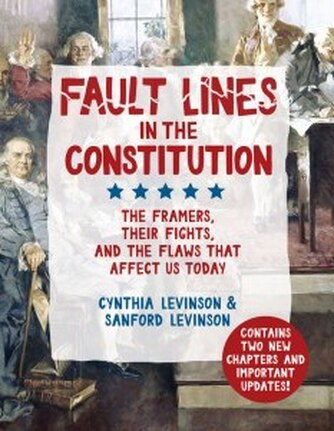
Researching and writing the books, I realized he was right: many issues in the news today can be traced directly back to what the Framers of our Constitution set in motion in Philadelphia in 1787.
We’re careful not to criticize the Framers. The handiwork they wrought—the government they created out of their reading, their negotiations, and their imaginations—was a marvel for the time.
For better or worse—and, as you can tell from our title, we believe, often for worse—this document has remained largely unchanged. Let me give you some examples of ways that 1787 still reverberates in 2020 and, undoubtedly, beyond. One of the ways, which we actually wrote about, deals with an epidemic that nearly became a global pandemic.
One of the ways, which we actually wrote about, deals with an epidemic that nearly became a global pandemic.
To show the link between 1787 and now, every chapter starts with a story; most of the stories are recent.
In “ At War with Bugs: Habeas Corpus ,” we talk about an American nurse who treated Ebola patients in Sierra Leone in 2014.
She had the misfortunate of returning to the Newark, New Jersey airport the very day that state’s governor, Chris Christy, imposed an unnecessarily restrictive quarantine.
Kaci Hickox was incarcerated in a tent in a hospital parking lot, and she sued for the great writ—that is, the right to be released—as promised in the Constitution.
For better or worse, our current federal government has not instituted national policies to stem the spread of COVID-19.
A future government might do so and would need to balance country-wide protections against a disease versus constitutionally guaranteed individual rights.
But, probably at the top of everyone’s list right now is the Electoral College. Why—WHY?!—do we have an Electoral College? No other country in the world has anything similar, and it wreaks havoc with our presidential campaigns and elections.
This really breaks down to two questions: Why did the Framers create it? And, why is it still hanging around?
How to elect the president—which was a novel idea at the time—hamstrung the participants at the Constitutional Convention for months. The method depended on what the executive’s duties would be and how he (they assumed it would be a he) would relate to Congress. Until they worked out these details, they couldn’t decide who would choose him—the people or the legislature. James Madison came up with the last-minute proposal of electors, which would allow far-flung voters who had barely heard of the candidates to choose the winner for them. His plan would also allow the House to pick the president and the Senate the vice president in case no one got a majority.
James Madison came up with the last-minute proposal of electors, which would allow far-flung voters who had barely heard of the candidates to choose the winner for them. His plan would also allow the House to pick the president and the Senate the vice president in case no one got a majority.
As we say in the book, that worked fine as long as George Washington was president.
I won’t go into all the mayhem this arrangement has caused over the centuries, except to say that the Electoral College has chosen the less popular candidate five times, so far.
So, why do we continue to tolerate its existence? Because of another fault line (my husband’s “favorite,” if favorite means most destructive)—the difficulty of amending the Constitution. It’s so complex and daunting, I’ll let Ally’s wonderful graphics lead you through the process.
 Thanks to First Second, you can read all of Chapter 12: the college with no courses or credits: the electoral college AND Chapter 19: at war with bugs: habeas corpus
right here!
In all, we discuss twenty fault lines. Unlike habeas corpus, none of them deals with rights.
Thanks to First Second, you can read all of Chapter 12: the college with no courses or credits: the electoral college AND Chapter 19: at war with bugs: habeas corpus
right here!
In all, we discuss twenty fault lines. Unlike habeas corpus, none of them deals with rights.
All of them address the structural underpinnings of our governmental system. For instance, while most of us tend to take such matters as our bicameral legislature, a Senate with two senators per state regardless of the size of the population of each state, and the president’s veto power for granted, all of these turn out to have deeply unjust ramifications.
Somehow, we skipped impeachment, which surely belongs in the next edition, if there is one. But, even if there isn’t, the book shows no signs of becoming obsolete. In fact, we blog updates and welcome responses every month at
www.faultlinesintheconstitution.com .
Please, join the conversation or add your own favorite fault line!
Thank you, Cynthia! Always great to have you on the blog. Some of you may remember a previous guest post by Cynthia Levinson. You can learn more about Cynthia and see all her books here.
That is not going to change now that Amy Comey Barrett has been confirmed to the Supreme Court cementing an "originalist" majority on the court for the first time in nearly a century. Originalists believe the court should decipher our Founding Father's precise meaning and intent and make sure it is carried out as the law of the land.
Others see the Constitution as a living document to be interpreted in light of changing thought and circumstance. This view has brought us labor rights and protections, equal rights for people of all colors, persuasions and genders. It's brought us social security, Medicare and, so far, allowed the Affordable Care Act to stand.
To shed more light on the Constitutional debate, I've invited author and friend Cynthia Levinson to tell you about her new kids' book and graphic novel Fault Lines in the Constitution. A graphic look at the
American Constitution
 We’re all too aware these days of the connections between 2020-21 and 1918-19. Viruses will always be with us, and, alas, novel ones that threaten our health and well-being will very likely recur.
We’re all too aware these days of the connections between 2020-21 and 1918-19. Viruses will always be with us, and, alas, novel ones that threaten our health and well-being will very likely recur.People have also seen similarities between autocratic leaders around the world today and those in the 1930s-1940s in Germany and elsewhere.
Similarly, for many years, my husband, Sanford Levinson , who is a constitutional scholar, has said, while looking at contemporary domestic political issues, “Follow the dots.” Follow them where? To our Constitution.
To tell you the truth, although I had read all of his books, I didn’t fully understand what he meant until he and I wrote a book for young readers together.
That has now turned into two books-- Fault Lines in the Constitution: The Framers, Their Fights, and the Flaws that Affect Us Today (Peachtree Publishers, 2017, updated in 2019) and Fault Lines in the Constitution: The Graphic Novel , illustrated by Ally Shwed (First Second/Macmillan, 2020).

Researching and writing the books, I realized he was right: many issues in the news today can be traced directly back to what the Framers of our Constitution set in motion in Philadelphia in 1787.
We’re careful not to criticize the Framers. The handiwork they wrought—the government they created out of their reading, their negotiations, and their imaginations—was a marvel for the time.
For better or worse—and, as you can tell from our title, we believe, often for worse—this document has remained largely unchanged. Let me give you some examples of ways that 1787 still reverberates in 2020 and, undoubtedly, beyond.
 One of the ways, which we actually wrote about, deals with an epidemic that nearly became a global pandemic.
One of the ways, which we actually wrote about, deals with an epidemic that nearly became a global pandemic.To show the link between 1787 and now, every chapter starts with a story; most of the stories are recent.
In “ At War with Bugs: Habeas Corpus ,” we talk about an American nurse who treated Ebola patients in Sierra Leone in 2014.
She had the misfortunate of returning to the Newark, New Jersey airport the very day that state’s governor, Chris Christy, imposed an unnecessarily restrictive quarantine.
Kaci Hickox was incarcerated in a tent in a hospital parking lot, and she sued for the great writ—that is, the right to be released—as promised in the Constitution.
For better or worse, our current federal government has not instituted national policies to stem the spread of COVID-19.
A future government might do so and would need to balance country-wide protections against a disease versus constitutionally guaranteed individual rights.
But, probably at the top of everyone’s list right now is the Electoral College. Why—WHY?!—do we have an Electoral College? No other country in the world has anything similar, and it wreaks havoc with our presidential campaigns and elections.
This really breaks down to two questions: Why did the Framers create it? And, why is it still hanging around?
How to elect the president—which was a novel idea at the time—hamstrung the participants at the Constitutional Convention for months. The method depended on what the executive’s duties would be and how he (they assumed it would be a he) would relate to Congress. Until they worked out these details, they couldn’t decide who would choose him—the people or the legislature.
 James Madison came up with the last-minute proposal of electors, which would allow far-flung voters who had barely heard of the candidates to choose the winner for them. His plan would also allow the House to pick the president and the Senate the vice president in case no one got a majority.
James Madison came up with the last-minute proposal of electors, which would allow far-flung voters who had barely heard of the candidates to choose the winner for them. His plan would also allow the House to pick the president and the Senate the vice president in case no one got a majority. As we say in the book, that worked fine as long as George Washington was president.
I won’t go into all the mayhem this arrangement has caused over the centuries, except to say that the Electoral College has chosen the less popular candidate five times, so far.
So, why do we continue to tolerate its existence? Because of another fault line (my husband’s “favorite,” if favorite means most destructive)—the difficulty of amending the Constitution. It’s so complex and daunting, I’ll let Ally’s wonderful graphics lead you through the process.

 Thanks to First Second, you can read all of Chapter 12: the college with no courses or credits: the electoral college AND Chapter 19: at war with bugs: habeas corpus
right here!
In all, we discuss twenty fault lines. Unlike habeas corpus, none of them deals with rights.
Thanks to First Second, you can read all of Chapter 12: the college with no courses or credits: the electoral college AND Chapter 19: at war with bugs: habeas corpus
right here!
In all, we discuss twenty fault lines. Unlike habeas corpus, none of them deals with rights.All of them address the structural underpinnings of our governmental system. For instance, while most of us tend to take such matters as our bicameral legislature, a Senate with two senators per state regardless of the size of the population of each state, and the president’s veto power for granted, all of these turn out to have deeply unjust ramifications.
Somehow, we skipped impeachment, which surely belongs in the next edition, if there is one. But, even if there isn’t, the book shows no signs of becoming obsolete. In fact, we blog updates and welcome responses every month at
www.faultlinesintheconstitution.com .
Please, join the conversation or add your own favorite fault line!
Thank you, Cynthia! Always great to have you on the blog. Some of you may remember a previous guest post by Cynthia Levinson. You can learn more about Cynthia and see all her books here.
Published on October 26, 2020 18:40
October 1, 2020
Straight Talk about Fake News
Here's a new book you'll want to put in the hands of young people you care about.
Guardians of Liberty: Freedom of the Press and the Nature of News takes an in-depth look at fake news.
Though it has been several decades since I officially worked as a journalist, freedom of the press is bone deep in my body. So, I've invited author Linda Barret Osborn here today to tell us about her new book, including the part about people living on the moon! Praise for the book—
Praise for the book—
"Deeply researched and beautifully written, Guardians of Liberty enlightens and entertains readers of any age. " — Michael Dirda, Pulitzer Prize-winning critic for the Washington Post
Welcome, Linda. Tell us how you came to write this book.
In 2017, I became alarmed at the way President Donald Trump was disparaging the press and questioning its validity.
I had some knowledge of the First Amendment, which reads, in part, “Congress shall make no law . . . abridging the freedom . . . of the press.”
But as with all my books for middle school and young adults, I learned a lot more about freedom of the press along the way than I knew at the beginning.
It seemed important that young people understand how today’s issues are connected to the beginning of our history as a country. Actually, I wish more grownups understood this history too.
One of the most delightful things I found in my research was that in 1835 the New York Sun reported that men were living on the moon.
These were no ordinary men.
 Lithograph illustrates the claim that life had been discovered on the moon. (New York Sun)
Lithograph illustrates the claim that life had been discovered on the moon. (New York Sun)
“They averaged four feet in height, were covered . . . with short and glossy copper-colored hair, and had wings” like bats. Unicorns also roamed the moon. So did a strange kind of beaver that walked upright on two legs.
The Sun explained that a respected South African astronomer had made the discovery using a huge telescope. New Yorkers rushed to buy the newspaper and read each day’s installment. When the story was revealed as a hoax—a great entertainment—sales of the Sun continued to rise.
The Sun’s moon story was an example of actual fake news. The paper’s editor knew it was false when he published it.
Fake news is not, as President Trump sees it, press about himself that he just doesn’t like.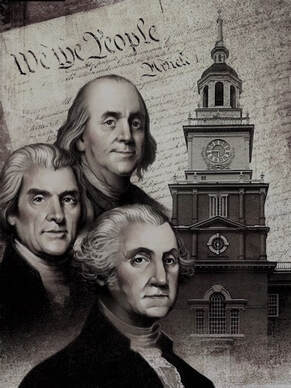 By attacking journalists, by undercutting the idea of factual reporting, it seems that President Trump was going against the intentions of the Founding Fathers who wrote that amendment.
By attacking journalists, by undercutting the idea of factual reporting, it seems that President Trump was going against the intentions of the Founding Fathers who wrote that amendment.
Men like Benjamin Franklin, Thomas Jefferson, and James Madison envisioned a press that would be a watchdog against government abuses of power.
Remember, they were reacting to the British royal government’s treatment of the colonies.
They also believed that a democracy needs an active, vital press representing all points of view: a press that would encourage debate and open discussion of ideas to create an informed citizenry.
Because Americans do hold widely differing points of view, no president can count on only “good” press.
So from the early days of our country, the First Amendment put the president—no matter what his political party—and the press at odds with each other. No president likes negative press.
Here was something else I wanted to explore and it soon became clear that combative, hurtful words about presidents are not new in our history. John Adams, Jefferson, Andrew Jackson, Abraham Lincoln, Woodrow Wilson, Richard Nixon, George W. Bush, and Barack Obama, as well as President Trump, have been ripped apart in the news.
Even George Washington got bad press. Benjamin Franklin’s grandson wrote that Washington had encouraged “political iniquity and . . . legalized corruption."
Sometimes the presidents remained silent. Sometimes they fought back against their critics. Sometimes they let partisan newspapers fight it out for them.
But by 2017, the “press” did not just include printed papers. Radio, television, the internet, and social media had all changed the way the news was delivered. The presses roll at the New York Times in 1942. Newspapers were printed this way from the early twentieth century until the rise of digital, computer-based printing. And because the technology had changed, President Trump could bypass the press, using social media directly to reach the public. He could continually attack the press as often as he wished, tweeting many times a day.
The presses roll at the New York Times in 1942. Newspapers were printed this way from the early twentieth century until the rise of digital, computer-based printing. And because the technology had changed, President Trump could bypass the press, using social media directly to reach the public. He could continually attack the press as often as he wished, tweeting many times a day.
Since I wrote Guardians of Liberty, people have asked me why I think Trump is different from other presidents and their attitudes towards the press. Nixon, after all, called the press “the enemy.”
But only Trump has called the press “the enemy of the people." "Don’t believe the crap you see from these people—the fake news,” he said to a VFW convention, pointing to the reporters. “What you’re seeing and what you’re reading is not what’s happening.”
I think all press, no matter what the medium, has its biases. Author Linda Barrett Osborne In addition, more Americans get their news from social media. Much of that “news” is opinion. Some of it is definitely fake, though not in the way President Trump defines it. So we all need to become better judges of the accuracy of what we are reading.
Author Linda Barrett Osborne In addition, more Americans get their news from social media. Much of that “news” is opinion. Some of it is definitely fake, though not in the way President Trump defines it. So we all need to become better judges of the accuracy of what we are reading.
In many ways, professional journalists, who have a standard of accuracy, are our best bet. But there are fairly easy ways to check anyone’s sources and statements. Tweets, press briefings, and speeches are on record. They are filmed and recorded. The White House itself posts the transcripts of speeches, so you can see what the president actually said and if and when he said the opposite.
Since the mid-twentieth century, the Supreme Court cases on press freedom I covered in my book have tended to uphold the First Amendment. The need for national security during war has been the biggest challenge to this freedom.
New technology has changed the nature of news. It should not change our belief in the importance of free expression in a democracy, the same belief the Founding Fathers held. I think we are at a turning point.
We can agree that disparaging and attacking the foundations of one of our most precious freedoms is acceptable; or we can believe, as a society, that freedom of the press is a principle we need to defend, practice, and value.
Thanks so much, Linda!
I'm going to be giving away several copies of Linda's book to middle school teachers. Sign up for my weekly newsletter to stay in the loop and find out how you can win.
Guardians of Liberty: Freedom of the Press and the Nature of News takes an in-depth look at fake news.
Though it has been several decades since I officially worked as a journalist, freedom of the press is bone deep in my body. So, I've invited author Linda Barret Osborn here today to tell us about her new book, including the part about people living on the moon!
 Praise for the book—
Praise for the book— "Deeply researched and beautifully written, Guardians of Liberty enlightens and entertains readers of any age. " — Michael Dirda, Pulitzer Prize-winning critic for the Washington Post
Welcome, Linda. Tell us how you came to write this book.
In 2017, I became alarmed at the way President Donald Trump was disparaging the press and questioning its validity.
I had some knowledge of the First Amendment, which reads, in part, “Congress shall make no law . . . abridging the freedom . . . of the press.”
But as with all my books for middle school and young adults, I learned a lot more about freedom of the press along the way than I knew at the beginning.
It seemed important that young people understand how today’s issues are connected to the beginning of our history as a country. Actually, I wish more grownups understood this history too.
One of the most delightful things I found in my research was that in 1835 the New York Sun reported that men were living on the moon.
These were no ordinary men.
 Lithograph illustrates the claim that life had been discovered on the moon. (New York Sun)
Lithograph illustrates the claim that life had been discovered on the moon. (New York Sun) “They averaged four feet in height, were covered . . . with short and glossy copper-colored hair, and had wings” like bats. Unicorns also roamed the moon. So did a strange kind of beaver that walked upright on two legs.
The Sun explained that a respected South African astronomer had made the discovery using a huge telescope. New Yorkers rushed to buy the newspaper and read each day’s installment. When the story was revealed as a hoax—a great entertainment—sales of the Sun continued to rise.
The Sun’s moon story was an example of actual fake news. The paper’s editor knew it was false when he published it.
Fake news is not, as President Trump sees it, press about himself that he just doesn’t like.
 By attacking journalists, by undercutting the idea of factual reporting, it seems that President Trump was going against the intentions of the Founding Fathers who wrote that amendment.
By attacking journalists, by undercutting the idea of factual reporting, it seems that President Trump was going against the intentions of the Founding Fathers who wrote that amendment.Men like Benjamin Franklin, Thomas Jefferson, and James Madison envisioned a press that would be a watchdog against government abuses of power.
Remember, they were reacting to the British royal government’s treatment of the colonies.
They also believed that a democracy needs an active, vital press representing all points of view: a press that would encourage debate and open discussion of ideas to create an informed citizenry.
Because Americans do hold widely differing points of view, no president can count on only “good” press.
So from the early days of our country, the First Amendment put the president—no matter what his political party—and the press at odds with each other. No president likes negative press.
Here was something else I wanted to explore and it soon became clear that combative, hurtful words about presidents are not new in our history. John Adams, Jefferson, Andrew Jackson, Abraham Lincoln, Woodrow Wilson, Richard Nixon, George W. Bush, and Barack Obama, as well as President Trump, have been ripped apart in the news.
Even George Washington got bad press. Benjamin Franklin’s grandson wrote that Washington had encouraged “political iniquity and . . . legalized corruption."
Sometimes the presidents remained silent. Sometimes they fought back against their critics. Sometimes they let partisan newspapers fight it out for them.
But by 2017, the “press” did not just include printed papers. Radio, television, the internet, and social media had all changed the way the news was delivered.
 The presses roll at the New York Times in 1942. Newspapers were printed this way from the early twentieth century until the rise of digital, computer-based printing. And because the technology had changed, President Trump could bypass the press, using social media directly to reach the public. He could continually attack the press as often as he wished, tweeting many times a day.
The presses roll at the New York Times in 1942. Newspapers were printed this way from the early twentieth century until the rise of digital, computer-based printing. And because the technology had changed, President Trump could bypass the press, using social media directly to reach the public. He could continually attack the press as often as he wished, tweeting many times a day.Since I wrote Guardians of Liberty, people have asked me why I think Trump is different from other presidents and their attitudes towards the press. Nixon, after all, called the press “the enemy.”
But only Trump has called the press “the enemy of the people." "Don’t believe the crap you see from these people—the fake news,” he said to a VFW convention, pointing to the reporters. “What you’re seeing and what you’re reading is not what’s happening.”
I think all press, no matter what the medium, has its biases.
 Author Linda Barrett Osborne In addition, more Americans get their news from social media. Much of that “news” is opinion. Some of it is definitely fake, though not in the way President Trump defines it. So we all need to become better judges of the accuracy of what we are reading.
Author Linda Barrett Osborne In addition, more Americans get their news from social media. Much of that “news” is opinion. Some of it is definitely fake, though not in the way President Trump defines it. So we all need to become better judges of the accuracy of what we are reading.In many ways, professional journalists, who have a standard of accuracy, are our best bet. But there are fairly easy ways to check anyone’s sources and statements. Tweets, press briefings, and speeches are on record. They are filmed and recorded. The White House itself posts the transcripts of speeches, so you can see what the president actually said and if and when he said the opposite.
Since the mid-twentieth century, the Supreme Court cases on press freedom I covered in my book have tended to uphold the First Amendment. The need for national security during war has been the biggest challenge to this freedom.
New technology has changed the nature of news. It should not change our belief in the importance of free expression in a democracy, the same belief the Founding Fathers held. I think we are at a turning point.
We can agree that disparaging and attacking the foundations of one of our most precious freedoms is acceptable; or we can believe, as a society, that freedom of the press is a principle we need to defend, practice, and value.
Thanks so much, Linda!
I'm going to be giving away several copies of Linda's book to middle school teachers. Sign up for my weekly newsletter to stay in the loop and find out how you can win.
Published on October 01, 2020 14:41
August 25, 2020
How Women Helped Weave a Proud Legacy of Lies and Distortion
In the early 1900s, some American women campaigned for suffrage, picketed, went to jail...
Other women formed a massive movement to erect monuments glorifying the Confederacy, re-write the history of the Civil War and indoctrinate children using a Confederate Catechism. (Link to catechism below.)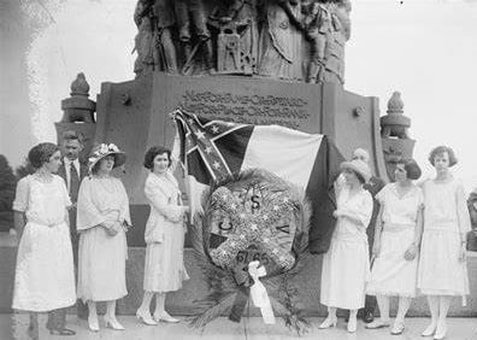 Confederate memorial services, June 5, 1922 These women wrote and controlled history textbooks in Alabama, Texas, Louisiana and other southern states for three generations.
Confederate memorial services, June 5, 1922 These women wrote and controlled history textbooks in Alabama, Texas, Louisiana and other southern states for three generations.
Textbooks that described a close friendship between "old massa" and slaves, picnics and barbeques thrown where slaves had a "great frolic," and stated how enslaved people sang as they worked in the fields, "the beat of the music and richness of their voices made work seem light."
Is it any wonder the confederate flag means so much to so many people? That Robert E. Lee is such a vaunted hero? They learned it in catechism! (See video after feature story below)
Today, Brandon Marie Miller, author of Robert E. Lee, the Man, the Soldier, the Myth , is here to help us separate fact from fiction. Welcome, Brandon! Breaking Down the Myths of Robert E. Lee Author Brandon Marie Miller I never thought my YA biography of Robert E. Lee would be so timely. But one way to fight racism and white supremacy is by accepting truths about our past. 150 years after his death, Lee remains in history’s spotlight.
Author Brandon Marie Miller I never thought my YA biography of Robert E. Lee would be so timely. But one way to fight racism and white supremacy is by accepting truths about our past. 150 years after his death, Lee remains in history’s spotlight.
Some people today still claim Lee did not own slaves, he hated slavery, he favored emancipation, and he promoted reconciliation after the Civil War. Let’s take a closer look.
Lee and Slavery
“Slavery as an institution,” Lee wrote his wife in 1856, “is a moral & political evil in any country.” Sounds good, right? But a sentence down in this same letter Lee explains “I think it however a greater evil to the white than to the black race.”
Lee believed God approved slavery as a means to civilize Black people. Even the “painful discipline” inflicted was “necessary for their instruction as a race.” For Lee, Black people were morally unfit for freedom and not as capable of learning as whites.
Photo below: Selina Norris Gray, the enslaved housekeeper at Robert E. Lee's home, Arlington, shown with two of her daughters. (Arlington House, The Robert E. Lee Memorial.) He felt slavery was messy, though, an inefficient system forcing “unwilling hands to work.” He disliked having to feed, clothe, and house people he found lazy and ungrateful.
He felt slavery was messy, though, an inefficient system forcing “unwilling hands to work.” He disliked having to feed, clothe, and house people he found lazy and ungrateful.
Lee wrote his new bride about their household slaves, “you may do with them as you please…But do not trouble yourself about them, as they are not worth it.”
After his father-in-law’s death, Lee inherited around 200 enslaved people. They were to be freed within five years. But Lee petitioned a court to keep these men, women, and children in bondage while he made his father-in-law’s plantations profitable.
The enslaved sabotaged Lee’s efforts. They ran away, broke items, and stole things. Lee had people whipped or rid himself of troublemakers by hiring them out or sending slaves to Richmond to be “disposed of…to the best advantage.”  Although against secession, once war loomed, Robert Lee resigned the U. S. Army commission he’d held for nearly 35 years. Within days, he accepted a commission as major general of Virginia’s forces.
Although against secession, once war loomed, Robert Lee resigned the U. S. Army commission he’d held for nearly 35 years. Within days, he accepted a commission as major general of Virginia’s forces.
Lee knew the Confederacy existed to protect slavery and the right to expand slavery into the western territories. He had resented the North’s attempts to block the spread of slavery into the west which threatened, he wrote, the “equal rights of our [Southern] citizens.” “The South…has been aggrieved by the acts of the North” he told his son, “... I feel the aggression.”
Did Lee believe in emancipation for enslaved people?
Lee believed in gradual emancipation which would only come when God decided, maybe not for thousands of years in the future. Lee did not free his family’s enslaved property until a court ordered him to obey his father-in-law’s will in 1862. Does that make him an emancipator?
Lee did approve one method for freeing slaves. In January 1865, three months before he surrendered, Lee advocated using slaves to fight for the Confederate Army.
However, across the trenches, tens of thousands of former slaves wore Union blue uniforms.
Lee needed soldiers and proposed giving “our negroes” freedom upon enlisting and freedom for their families at the end of the war, though this came too late in the war to matter. Does this make Lee an emancipator?
Did Lee work for reconciliation after the war?
Lee urged fellow Southerners to “promote harmony and good feelings” as the quickest means to regain voting rights for white men and rebuild southern prosperity.
After the war Lee served as president of Washington College where he implemented rigorous programs to educate and uplift young men of the South.
But Lee’s words of reconciliation gave way to anger as the “evil legislation of Congress” granted civil rights to the former enslaved. Washington College students harassed African Americans, destroyed a Freedman’s Bureau school, and nearly lynched a man.
The President's House that Lee designed and built at Washington College. (Special Collections Department, Washington and Lee University) Lee disciplined a few ring leaders but never spoke out publicly against the violence toward African Americans sweeping the South. His response emphasized instead how students disturbed “the public peace, or bring discredit upon themselves or the institution to which they belong.”
Lee disciplined a few ring leaders but never spoke out publicly against the violence toward African Americans sweeping the South. His response emphasized instead how students disturbed “the public peace, or bring discredit upon themselves or the institution to which they belong.”
Lee rejected this new world where “the South is to be placed under the dominion of the negroes.” Publicly he claimed he wished the former enslaved well, but privately Lee wrote, “Remember, our material, social, and political interests are naturally with the whites.”
In 1868 Lee signed a political statement known as the White Sulphur Springs Manifesto. The signers pledged to treat Blacks with “kindness and humanity,” while opposing any “laws which will place the political power of the country in the hands of the negro race.”
This statement, and others, helped justify continued violence against African Americans for participating in the American political system. How did the reality of Lee’s racism and white supremacy get turned around?
How did the reality of Lee’s racism and white supremacy get turned around?
In June of 1870 Lee wrote a cousin he hoped to shape “the opinion which posterity may form of the motives which governed the South in their late struggle.”
He began reframing the war as a political quarrel-- the North strayed from the ideals of the Constitution while the South fought to maintain “those principles of American liberty.”
He’d fought for state’s rights, not the cause of protecting slavery, Lee claimed. He disregarded the fact that the state’s rights insisted upon in 1860 and 1861 had been the right to own slaves and spread slavery into the west.
In the decades after Lee’s death in October 1870, the handsome hero image of Lee grew to saint-like perfection. The ugliness of slavery could not tarnish this mythical man.
Over time, the myth that he didn’t own slaves and supported emancipation became truth in the South and the North. Lee became a symbol of a righteous South. For many white Americans the soothing myth of Lee as a kind, honorable, Christian Gentleman, was more important than the economic suppression, voting suppression, and murder of African Americans.
Groups like the United Confederate Veterans (founded 1889) and The United Daughters of the Confederacy (founded 1894), worked tirelessly to vindicate the Old South, intentionally rewriting history.
The UDC distributed a booklet nation-wide to control what appeared in textbooks, shaping our Civil War memory for generations.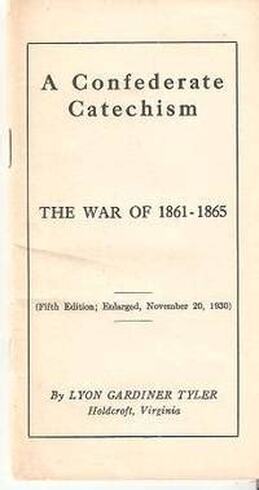 Among the reasons listed to condemn a book:
“Reject a book that says the South fought to hold her slaves. Reject a book that speaks of the slaveholder of the South as cruel and unjust to his slaves. Reject a text book that glorifies Abraham Lincoln and vilifies Jefferson Davis….”
Among the reasons listed to condemn a book:
“Reject a book that says the South fought to hold her slaves. Reject a book that speaks of the slaveholder of the South as cruel and unjust to his slaves. Reject a text book that glorifies Abraham Lincoln and vilifies Jefferson Davis….”
Lee’s portrait graced thousands of Southern classrooms; many celebrated his birthday. Members of The Children of the Confederacy recited from A Confederate Catechism, first published in 1904.
It included lessons like this one: “What did the South fight for? It fought to repel invasion and for self-government, just as the fathers of the American Revolution had done.”
As Jim Crow laws stripped civil rights from African Americans and sharecropping became a new form of slavery, statues of Confederate heroes rose in cities across the South.
Dedication ceremonies included parades, speeches, and hundreds of children arranged into “living” Confederate battle flags. The monuments reinforced white Southerners’ pride in the past, romanticized the Old South and slavery, and warned African Americans to keep to their place.
I spent years researching and writing this book and have used Lee’s own words, and the words of his family and friends, to tell the story. I’m grateful ROBERT E. LEE, THE MAN, THE SOLDIER, THE MYTH was named a National Council of the Social Studies Notable Book and a Bank Street College Best Book of the Year. If you’d like to know more, order a copy from your favorite bookstore or online here...
Thank you, Brandon! I'm so appreciative of you taking time to tell us about your new book, and to help us understand more about the roots of racial injustice in our nation and the concerted efforts to re-write history.
Also thanks to author Claire Rudolf Murphy for alerting me to this video below about the women who helped distort the truth of the Civil War, construct a false legacy and indoctrinate children.
Other women formed a massive movement to erect monuments glorifying the Confederacy, re-write the history of the Civil War and indoctrinate children using a Confederate Catechism. (Link to catechism below.)
 Confederate memorial services, June 5, 1922 These women wrote and controlled history textbooks in Alabama, Texas, Louisiana and other southern states for three generations.
Confederate memorial services, June 5, 1922 These women wrote and controlled history textbooks in Alabama, Texas, Louisiana and other southern states for three generations.Textbooks that described a close friendship between "old massa" and slaves, picnics and barbeques thrown where slaves had a "great frolic," and stated how enslaved people sang as they worked in the fields, "the beat of the music and richness of their voices made work seem light."
Is it any wonder the confederate flag means so much to so many people? That Robert E. Lee is such a vaunted hero? They learned it in catechism! (See video after feature story below)
Today, Brandon Marie Miller, author of Robert E. Lee, the Man, the Soldier, the Myth , is here to help us separate fact from fiction. Welcome, Brandon! Breaking Down the Myths of Robert E. Lee
 Author Brandon Marie Miller I never thought my YA biography of Robert E. Lee would be so timely. But one way to fight racism and white supremacy is by accepting truths about our past. 150 years after his death, Lee remains in history’s spotlight.
Author Brandon Marie Miller I never thought my YA biography of Robert E. Lee would be so timely. But one way to fight racism and white supremacy is by accepting truths about our past. 150 years after his death, Lee remains in history’s spotlight.Some people today still claim Lee did not own slaves, he hated slavery, he favored emancipation, and he promoted reconciliation after the Civil War. Let’s take a closer look.
Lee and Slavery
“Slavery as an institution,” Lee wrote his wife in 1856, “is a moral & political evil in any country.” Sounds good, right? But a sentence down in this same letter Lee explains “I think it however a greater evil to the white than to the black race.”
Lee believed God approved slavery as a means to civilize Black people. Even the “painful discipline” inflicted was “necessary for their instruction as a race.” For Lee, Black people were morally unfit for freedom and not as capable of learning as whites.
Photo below: Selina Norris Gray, the enslaved housekeeper at Robert E. Lee's home, Arlington, shown with two of her daughters. (Arlington House, The Robert E. Lee Memorial.)
 He felt slavery was messy, though, an inefficient system forcing “unwilling hands to work.” He disliked having to feed, clothe, and house people he found lazy and ungrateful.
He felt slavery was messy, though, an inefficient system forcing “unwilling hands to work.” He disliked having to feed, clothe, and house people he found lazy and ungrateful.Lee wrote his new bride about their household slaves, “you may do with them as you please…But do not trouble yourself about them, as they are not worth it.”
After his father-in-law’s death, Lee inherited around 200 enslaved people. They were to be freed within five years. But Lee petitioned a court to keep these men, women, and children in bondage while he made his father-in-law’s plantations profitable.
The enslaved sabotaged Lee’s efforts. They ran away, broke items, and stole things. Lee had people whipped or rid himself of troublemakers by hiring them out or sending slaves to Richmond to be “disposed of…to the best advantage.”
 Although against secession, once war loomed, Robert Lee resigned the U. S. Army commission he’d held for nearly 35 years. Within days, he accepted a commission as major general of Virginia’s forces.
Although against secession, once war loomed, Robert Lee resigned the U. S. Army commission he’d held for nearly 35 years. Within days, he accepted a commission as major general of Virginia’s forces.Lee knew the Confederacy existed to protect slavery and the right to expand slavery into the western territories. He had resented the North’s attempts to block the spread of slavery into the west which threatened, he wrote, the “equal rights of our [Southern] citizens.” “The South…has been aggrieved by the acts of the North” he told his son, “... I feel the aggression.”
Did Lee believe in emancipation for enslaved people?
Lee believed in gradual emancipation which would only come when God decided, maybe not for thousands of years in the future. Lee did not free his family’s enslaved property until a court ordered him to obey his father-in-law’s will in 1862. Does that make him an emancipator?
Lee did approve one method for freeing slaves. In January 1865, three months before he surrendered, Lee advocated using slaves to fight for the Confederate Army.
However, across the trenches, tens of thousands of former slaves wore Union blue uniforms.
Lee needed soldiers and proposed giving “our negroes” freedom upon enlisting and freedom for their families at the end of the war, though this came too late in the war to matter. Does this make Lee an emancipator?
Did Lee work for reconciliation after the war?
Lee urged fellow Southerners to “promote harmony and good feelings” as the quickest means to regain voting rights for white men and rebuild southern prosperity.
After the war Lee served as president of Washington College where he implemented rigorous programs to educate and uplift young men of the South.
But Lee’s words of reconciliation gave way to anger as the “evil legislation of Congress” granted civil rights to the former enslaved. Washington College students harassed African Americans, destroyed a Freedman’s Bureau school, and nearly lynched a man.
The President's House that Lee designed and built at Washington College. (Special Collections Department, Washington and Lee University)
 Lee disciplined a few ring leaders but never spoke out publicly against the violence toward African Americans sweeping the South. His response emphasized instead how students disturbed “the public peace, or bring discredit upon themselves or the institution to which they belong.”
Lee disciplined a few ring leaders but never spoke out publicly against the violence toward African Americans sweeping the South. His response emphasized instead how students disturbed “the public peace, or bring discredit upon themselves or the institution to which they belong.”
Lee rejected this new world where “the South is to be placed under the dominion of the negroes.” Publicly he claimed he wished the former enslaved well, but privately Lee wrote, “Remember, our material, social, and political interests are naturally with the whites.”
In 1868 Lee signed a political statement known as the White Sulphur Springs Manifesto. The signers pledged to treat Blacks with “kindness and humanity,” while opposing any “laws which will place the political power of the country in the hands of the negro race.”
This statement, and others, helped justify continued violence against African Americans for participating in the American political system.
 How did the reality of Lee’s racism and white supremacy get turned around?
How did the reality of Lee’s racism and white supremacy get turned around?In June of 1870 Lee wrote a cousin he hoped to shape “the opinion which posterity may form of the motives which governed the South in their late struggle.”
He began reframing the war as a political quarrel-- the North strayed from the ideals of the Constitution while the South fought to maintain “those principles of American liberty.”
He’d fought for state’s rights, not the cause of protecting slavery, Lee claimed. He disregarded the fact that the state’s rights insisted upon in 1860 and 1861 had been the right to own slaves and spread slavery into the west.
In the decades after Lee’s death in October 1870, the handsome hero image of Lee grew to saint-like perfection. The ugliness of slavery could not tarnish this mythical man.
Over time, the myth that he didn’t own slaves and supported emancipation became truth in the South and the North. Lee became a symbol of a righteous South. For many white Americans the soothing myth of Lee as a kind, honorable, Christian Gentleman, was more important than the economic suppression, voting suppression, and murder of African Americans.
Groups like the United Confederate Veterans (founded 1889) and The United Daughters of the Confederacy (founded 1894), worked tirelessly to vindicate the Old South, intentionally rewriting history.
The UDC distributed a booklet nation-wide to control what appeared in textbooks, shaping our Civil War memory for generations.
 Among the reasons listed to condemn a book:
“Reject a book that says the South fought to hold her slaves. Reject a book that speaks of the slaveholder of the South as cruel and unjust to his slaves. Reject a text book that glorifies Abraham Lincoln and vilifies Jefferson Davis….”
Among the reasons listed to condemn a book:
“Reject a book that says the South fought to hold her slaves. Reject a book that speaks of the slaveholder of the South as cruel and unjust to his slaves. Reject a text book that glorifies Abraham Lincoln and vilifies Jefferson Davis….”
Lee’s portrait graced thousands of Southern classrooms; many celebrated his birthday. Members of The Children of the Confederacy recited from A Confederate Catechism, first published in 1904.
It included lessons like this one: “What did the South fight for? It fought to repel invasion and for self-government, just as the fathers of the American Revolution had done.”
As Jim Crow laws stripped civil rights from African Americans and sharecropping became a new form of slavery, statues of Confederate heroes rose in cities across the South.
Dedication ceremonies included parades, speeches, and hundreds of children arranged into “living” Confederate battle flags. The monuments reinforced white Southerners’ pride in the past, romanticized the Old South and slavery, and warned African Americans to keep to their place.
I spent years researching and writing this book and have used Lee’s own words, and the words of his family and friends, to tell the story. I’m grateful ROBERT E. LEE, THE MAN, THE SOLDIER, THE MYTH was named a National Council of the Social Studies Notable Book and a Bank Street College Best Book of the Year. If you’d like to know more, order a copy from your favorite bookstore or online here...
Thank you, Brandon! I'm so appreciative of you taking time to tell us about your new book, and to help us understand more about the roots of racial injustice in our nation and the concerted efforts to re-write history.
Also thanks to author Claire Rudolf Murphy for alerting me to this video below about the women who helped distort the truth of the Civil War, construct a false legacy and indoctrinate children.
Published on August 25, 2020 10:56
August 12, 2020
Sioux Suffragist Zitkala-Ša: Warrior for Native American Rights
Zitkala-Ša, also known as Gertrude Simmons Bonnin, became a "Joan of Arc" figure who led her people in the arduous effort to gain citizenship and suffrage.
You will not fine either of her names not chiseled into the monuments of history with the many white women who fought for the right to vote. But her story reads like a novel that you cannot put down.
Photo below: (Original Caption) 2/1921-Among the prominent women who attended the meeting of the National Women's party in Washington was Mrs. Gerturde Bonnin, nee Princess Zitkala-Sa of the Sioux. Courtesy National Women’s Party.  The 19th Amendment ratified 100-years ago, August 18, 1920, granted American women the right to vote, but indigenous people were not considered Americans.
The 19th Amendment ratified 100-years ago, August 18, 1920, granted American women the right to vote, but indigenous people were not considered Americans.
The U.S. refused Native Americans birthright citizenship, and also allowed no process for them to become naturalized as immigrants could.
Zitkala-Ša (Red Bird) fought for native citizenship, which was finally granted by Congress in 1924, four years after women gained the right to vote.
But even as citizens, Indian women couldn't automatically vote, some were refused suffrage until 1962. Not a typo. 1962. Scroll down for more on that, but we'll get to it. First, Zitkala-Ša.
This multi-talented woman was born on the Yankton Sioux Reservation in South Dakota in 1876 (the year of the Battle of Little Big Horn, known to Plains Indians as the Battle of the Greasy Grass and historically as Custer's Last Stand). She was eight years old when Quaker missionaries came to the reservation to get children for their boarding school. Zitkala-Ša would later write that her years at White's Indiana Manual Labor Institute were "both a revelation and a misery."
Check out this newspaper article heralding the success of the students at White's Institute. White's Institute, founded as an integrated school for all races had languished for twenty years, unable to attract boarding students, teachers and staff. Then in 1882, White's board of directors decided to contract with the U.S. government to educate native students.
White's Institute, founded as an integrated school for all races had languished for twenty years, unable to attract boarding students, teachers and staff. Then in 1882, White's board of directors decided to contract with the U.S. government to educate native students.
The school devoted itself to assimilating them into white society. The newspaper reported: Twenty seven Sioux children arrived for a three-year course of study. They were unkempt, ignorant and coarse, and true to their natural instincts were as shiftless.
Below is a photo of the first class arriving at White's. Zitkala-Ša started at the school a year or two later. Photo courtesy: https://www.worthpoint.com/worthopedi...
Photo courtesy: https://www.worthpoint.com/worthopedi...
Stripped of her native clothing and forbidden to speak her native language, Zitkala-Ša ran and hid the day she was scheduled to get her hair cut.
"Late in the morning, my friend Judewin gave me a terrible warning. Judewin knew a few words of English; and she had overheard the paleface woman talk about cutting our long, heavy hair.
Our mothers had taught us that only unskilled warriors who were captured had their hair shingled [cut] by the enemy. Among our people, short hair was worn by mourners, and shingled [cut] hair by cowards!...
I cried aloud, shaking my head all the while until I felt the cold blades of the scissors against my neck, and heard them gnaw off one of my thick braids," Zitkala-Ša remembered later.
"Then I lost my spirit"
"We’d lost our hair and we’d lost our clothes; with the two we’d lost our identity as Indians." remembered another former boarding student Francis LaFlesche.
" Greater punishment could hardly be devised.”
The local newspaper reported: "Except in studies requiring close reasoning the progress made by the pupils after mastering the English language is as rapid as that of the average English student. They appear, however, unable to arrive at logical conclusions and read deductions intuitively. Rarely, indeed, do they betray any sign of homesickness…"
Despite the indignities, punishment and being forced to pray as a Quaker, Zitkala-Ša
discovered great joy in learning to read and write English and to play the violin.
Photo below by Gertrude Kasebier, 1898. Smithsonian Institution, Public Domain After several years at White's Zitkala-Ša went back to her home on the reservation, but discovered that she did not fit in there. She returned to the school and continued her education.
After several years at White's Zitkala-Ša went back to her home on the reservation, but discovered that she did not fit in there. She returned to the school and continued her education.
At her graduation ceremony she gave a speech calling for women's right to vote. Earning a scholarship to Earlham College, she excelled in her liberal arts studies.
At Earlham, Zitkala-Ša started her writing career, gathering Native American stories
and translating them into English and Latin. She evolved the skills that would make her a powerful activist, once winning a speech contest in the the face of a big poster calling her a "squaw".
Following Earlham, she studied violin at the New England Conservatory of Music, once playing before President William McKinley.
While succeeding in white society, Zitkala-Ša remained anguished at her separation from Sioux culture. Hired at Carlisle Indian Industrial School in Pennsylvania to teach music, she found herself face to face with students stripped of their Native identity as she had been.
The rift inside her cracked wide when Carlisle sent her to Yankton to collected more students. She found the reservation swamped in poverty, her mother's home falling apart and white settlers violating Dakota lands in violation of federal treaties.
By now, she was a published writer and her short stories published in Atlantic Monthly and Harper's portrayed the wisdom and generosity of her people, and belied the bigoted notions so commonly accepted by mainstream Americans. Her writing criticized Carlisle and other boarding schools for their assimilation practices. She was fired.
Zitkala-Ša connected with other Native Americans capitalizing on their formal education and flawless English to advance the rights of Indian People. She helped establish the National Council of American Indians and committed herself to working for citizenship for Native Americans.
They made huge progress in 1924 when an act of Congress granted full citizenship to all of the approximately 125,000 of 300,000 indigenous people living in the United States. But the parameters of those rights would be drawn by individual states where legislators and voters harbored stubborn prejudices.
Native Americans registering to vote circa 1948. Bettmann Archive/Getty Images Arizona – home to part of the Navajo Nation and with the second-largest Native population in the country did not allow Native Americans to vote until the Supreme Court overruled the state's ban 1948. The State of Maine approved Native American Voting rights in 1953, with 25% of voters in opposition. Utah and New Mexico withheld the ballot box from Native Americans until 1962.
Arizona – home to part of the Navajo Nation and with the second-largest Native population in the country did not allow Native Americans to vote until the Supreme Court overruled the state's ban 1948. The State of Maine approved Native American Voting rights in 1953, with 25% of voters in opposition. Utah and New Mexico withheld the ballot box from Native Americans until 1962.
Like African Americans, Natives suffered continued hurdles to voting until the1965 Civil Rights Act, and their voting rights remain under attack today. Many will run into trouble voting in the upcoming presidential election.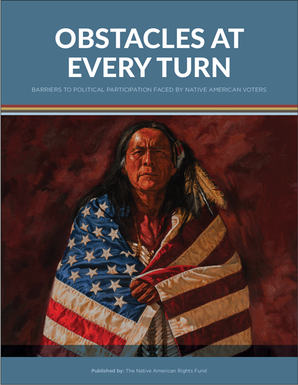 That's because in 2013, the Supreme Court extracted the teeth from the Civil Rights Act. In an Alabama case Shelby County vs Holder, the court declared the strong arm of the law unconstitutional, the section that required states with a history of racial bias in voting to get federal permission before enacting new voting laws.
That's because in 2013, the Supreme Court extracted the teeth from the Civil Rights Act. In an Alabama case Shelby County vs Holder, the court declared the strong arm of the law unconstitutional, the section that required states with a history of racial bias in voting to get federal permission before enacting new voting laws.
Since then a flurry of states and counties
have changed voting regulations to constrain Native Americans and people of color from voting. Two months ago, the Native American Voting Rights Coalition released details of an extensive research project.
Obstacles at Every Turn: Barriers to Political Participation Faced by Native American Voters lays bare the troubles Natives have in registering to vote, casting their votes and having their votes counted.
It's a disgrace.
Check these links for some of the latest state actions on Native American voting rights: Voter restrictions in North Dakota and historic voter rights legislation in Washington.
Zitkala-Ša wrote stories and poetry, she was a teacher and a musician who raised her voice and worked for justice. Living and working on the Uintah-Ouray Reservation in Utah, Zitkala-Ša collaborated with a professor at Brigham Young University to compose The Sundance Opera, which premiered in 1913, the first Native American Opera ever performed.
Often Zitkala-Ša has not been credited for the composition, though it's believed she wrote the libretto and songs of the opera, which was based on a sacred Sioux ritual that had been prohibited by the federal government.
In this time of great division in the U.S. we truly need the spirit of Zitkala-Ša. She never denied the searing ache of two opposite ways of life, of two different modes of thinking. Somehow, she brought them together within herself and created great beauty, strength and hope.
Sources:
https://learninglab.si.edu/resources/view/48790#more-info
https://www.nps.gov/people/zitkala-sa.htm
https://build.headonwest.com/the-gifted-and-conflicted-life-of-lakotas-zitkala-sa/
You will not fine either of her names not chiseled into the monuments of history with the many white women who fought for the right to vote. But her story reads like a novel that you cannot put down.
Photo below: (Original Caption) 2/1921-Among the prominent women who attended the meeting of the National Women's party in Washington was Mrs. Gerturde Bonnin, nee Princess Zitkala-Sa of the Sioux. Courtesy National Women’s Party.
 The 19th Amendment ratified 100-years ago, August 18, 1920, granted American women the right to vote, but indigenous people were not considered Americans.
The 19th Amendment ratified 100-years ago, August 18, 1920, granted American women the right to vote, but indigenous people were not considered Americans.The U.S. refused Native Americans birthright citizenship, and also allowed no process for them to become naturalized as immigrants could.
Zitkala-Ša (Red Bird) fought for native citizenship, which was finally granted by Congress in 1924, four years after women gained the right to vote.
But even as citizens, Indian women couldn't automatically vote, some were refused suffrage until 1962. Not a typo. 1962. Scroll down for more on that, but we'll get to it. First, Zitkala-Ša.
This multi-talented woman was born on the Yankton Sioux Reservation in South Dakota in 1876 (the year of the Battle of Little Big Horn, known to Plains Indians as the Battle of the Greasy Grass and historically as Custer's Last Stand). She was eight years old when Quaker missionaries came to the reservation to get children for their boarding school. Zitkala-Ša would later write that her years at White's Indiana Manual Labor Institute were "both a revelation and a misery."
Check out this newspaper article heralding the success of the students at White's Institute.
 White's Institute, founded as an integrated school for all races had languished for twenty years, unable to attract boarding students, teachers and staff. Then in 1882, White's board of directors decided to contract with the U.S. government to educate native students.
White's Institute, founded as an integrated school for all races had languished for twenty years, unable to attract boarding students, teachers and staff. Then in 1882, White's board of directors decided to contract with the U.S. government to educate native students.The school devoted itself to assimilating them into white society. The newspaper reported: Twenty seven Sioux children arrived for a three-year course of study. They were unkempt, ignorant and coarse, and true to their natural instincts were as shiftless.
Below is a photo of the first class arriving at White's. Zitkala-Ša started at the school a year or two later.
 Photo courtesy: https://www.worthpoint.com/worthopedi...
Photo courtesy: https://www.worthpoint.com/worthopedi...Stripped of her native clothing and forbidden to speak her native language, Zitkala-Ša ran and hid the day she was scheduled to get her hair cut.
"Late in the morning, my friend Judewin gave me a terrible warning. Judewin knew a few words of English; and she had overheard the paleface woman talk about cutting our long, heavy hair.
Our mothers had taught us that only unskilled warriors who were captured had their hair shingled [cut] by the enemy. Among our people, short hair was worn by mourners, and shingled [cut] hair by cowards!...
I cried aloud, shaking my head all the while until I felt the cold blades of the scissors against my neck, and heard them gnaw off one of my thick braids," Zitkala-Ša remembered later.
"Then I lost my spirit"
"We’d lost our hair and we’d lost our clothes; with the two we’d lost our identity as Indians." remembered another former boarding student Francis LaFlesche.
" Greater punishment could hardly be devised.”
The local newspaper reported: "Except in studies requiring close reasoning the progress made by the pupils after mastering the English language is as rapid as that of the average English student. They appear, however, unable to arrive at logical conclusions and read deductions intuitively. Rarely, indeed, do they betray any sign of homesickness…"
Despite the indignities, punishment and being forced to pray as a Quaker, Zitkala-Ša
discovered great joy in learning to read and write English and to play the violin.
Photo below by Gertrude Kasebier, 1898. Smithsonian Institution, Public Domain
 After several years at White's Zitkala-Ša went back to her home on the reservation, but discovered that she did not fit in there. She returned to the school and continued her education.
After several years at White's Zitkala-Ša went back to her home on the reservation, but discovered that she did not fit in there. She returned to the school and continued her education.At her graduation ceremony she gave a speech calling for women's right to vote. Earning a scholarship to Earlham College, she excelled in her liberal arts studies.
At Earlham, Zitkala-Ša started her writing career, gathering Native American stories
and translating them into English and Latin. She evolved the skills that would make her a powerful activist, once winning a speech contest in the the face of a big poster calling her a "squaw".
Following Earlham, she studied violin at the New England Conservatory of Music, once playing before President William McKinley.
While succeeding in white society, Zitkala-Ša remained anguished at her separation from Sioux culture. Hired at Carlisle Indian Industrial School in Pennsylvania to teach music, she found herself face to face with students stripped of their Native identity as she had been.
The rift inside her cracked wide when Carlisle sent her to Yankton to collected more students. She found the reservation swamped in poverty, her mother's home falling apart and white settlers violating Dakota lands in violation of federal treaties.
By now, she was a published writer and her short stories published in Atlantic Monthly and Harper's portrayed the wisdom and generosity of her people, and belied the bigoted notions so commonly accepted by mainstream Americans. Her writing criticized Carlisle and other boarding schools for their assimilation practices. She was fired.
Zitkala-Ša connected with other Native Americans capitalizing on their formal education and flawless English to advance the rights of Indian People. She helped establish the National Council of American Indians and committed herself to working for citizenship for Native Americans.
They made huge progress in 1924 when an act of Congress granted full citizenship to all of the approximately 125,000 of 300,000 indigenous people living in the United States. But the parameters of those rights would be drawn by individual states where legislators and voters harbored stubborn prejudices.
Native Americans registering to vote circa 1948. Bettmann Archive/Getty Images
 Arizona – home to part of the Navajo Nation and with the second-largest Native population in the country did not allow Native Americans to vote until the Supreme Court overruled the state's ban 1948. The State of Maine approved Native American Voting rights in 1953, with 25% of voters in opposition. Utah and New Mexico withheld the ballot box from Native Americans until 1962.
Arizona – home to part of the Navajo Nation and with the second-largest Native population in the country did not allow Native Americans to vote until the Supreme Court overruled the state's ban 1948. The State of Maine approved Native American Voting rights in 1953, with 25% of voters in opposition. Utah and New Mexico withheld the ballot box from Native Americans until 1962.Like African Americans, Natives suffered continued hurdles to voting until the1965 Civil Rights Act, and their voting rights remain under attack today. Many will run into trouble voting in the upcoming presidential election.
 That's because in 2013, the Supreme Court extracted the teeth from the Civil Rights Act. In an Alabama case Shelby County vs Holder, the court declared the strong arm of the law unconstitutional, the section that required states with a history of racial bias in voting to get federal permission before enacting new voting laws.
That's because in 2013, the Supreme Court extracted the teeth from the Civil Rights Act. In an Alabama case Shelby County vs Holder, the court declared the strong arm of the law unconstitutional, the section that required states with a history of racial bias in voting to get federal permission before enacting new voting laws.Since then a flurry of states and counties
have changed voting regulations to constrain Native Americans and people of color from voting. Two months ago, the Native American Voting Rights Coalition released details of an extensive research project.
Obstacles at Every Turn: Barriers to Political Participation Faced by Native American Voters lays bare the troubles Natives have in registering to vote, casting their votes and having their votes counted.
It's a disgrace.
Check these links for some of the latest state actions on Native American voting rights: Voter restrictions in North Dakota and historic voter rights legislation in Washington.
Zitkala-Ša wrote stories and poetry, she was a teacher and a musician who raised her voice and worked for justice. Living and working on the Uintah-Ouray Reservation in Utah, Zitkala-Ša collaborated with a professor at Brigham Young University to compose The Sundance Opera, which premiered in 1913, the first Native American Opera ever performed.
Often Zitkala-Ša has not been credited for the composition, though it's believed she wrote the libretto and songs of the opera, which was based on a sacred Sioux ritual that had been prohibited by the federal government.
In this time of great division in the U.S. we truly need the spirit of Zitkala-Ša. She never denied the searing ache of two opposite ways of life, of two different modes of thinking. Somehow, she brought them together within herself and created great beauty, strength and hope.
Sources:
https://learninglab.si.edu/resources/view/48790#more-info
https://www.nps.gov/people/zitkala-sa.htm
https://build.headonwest.com/the-gifted-and-conflicted-life-of-lakotas-zitkala-sa/
Published on August 12, 2020 15:02



